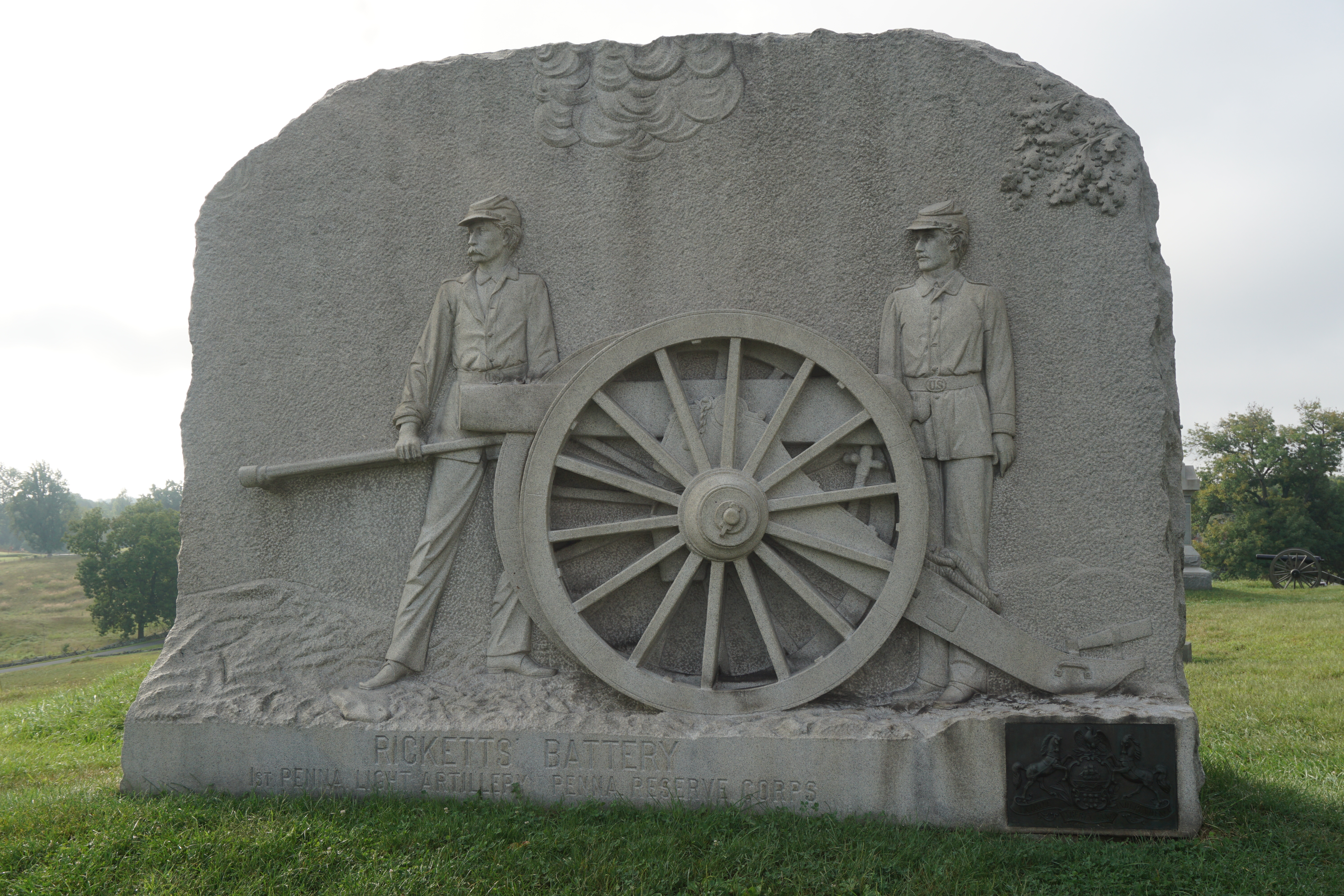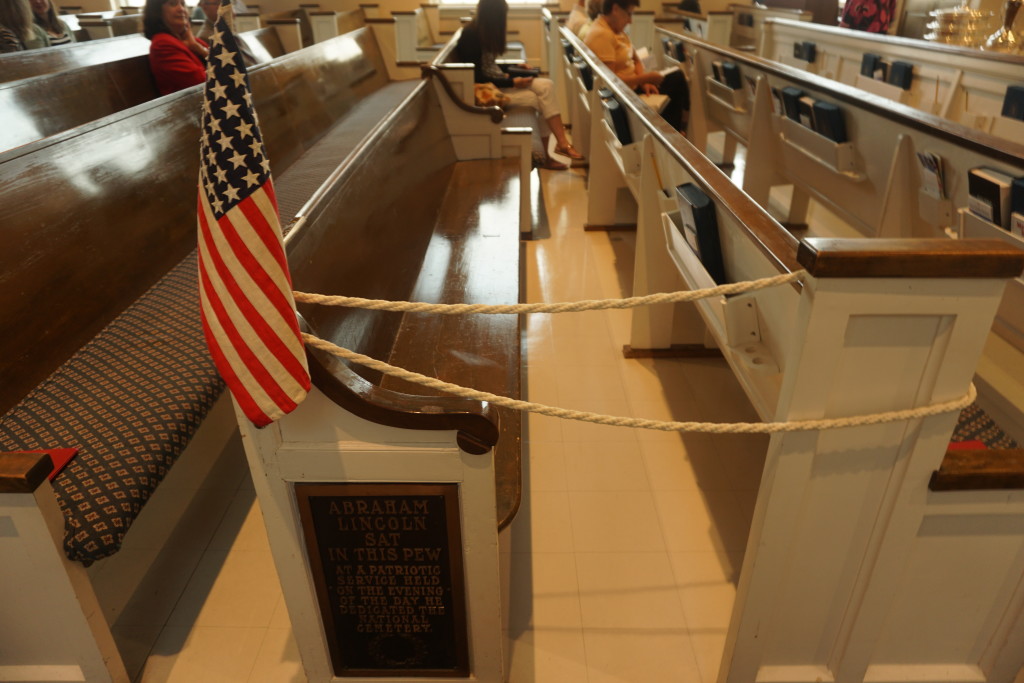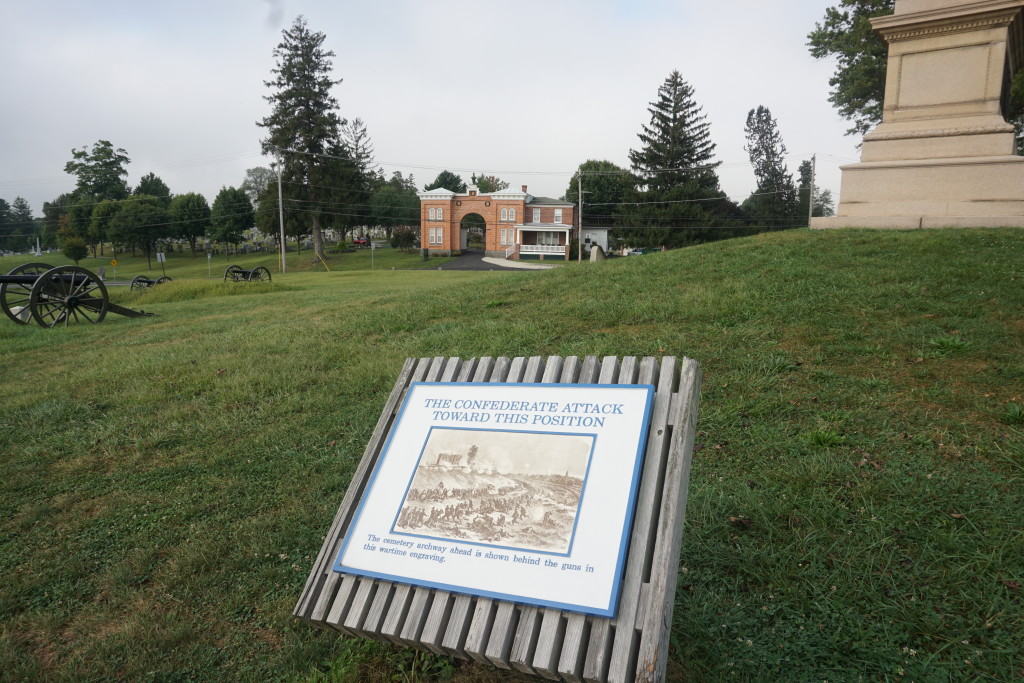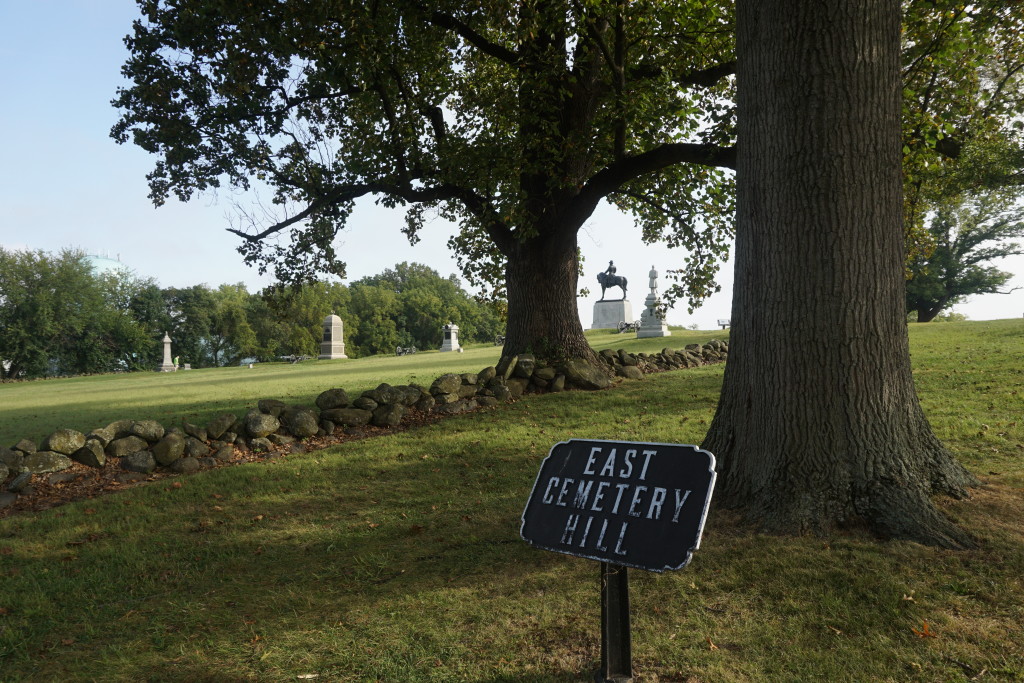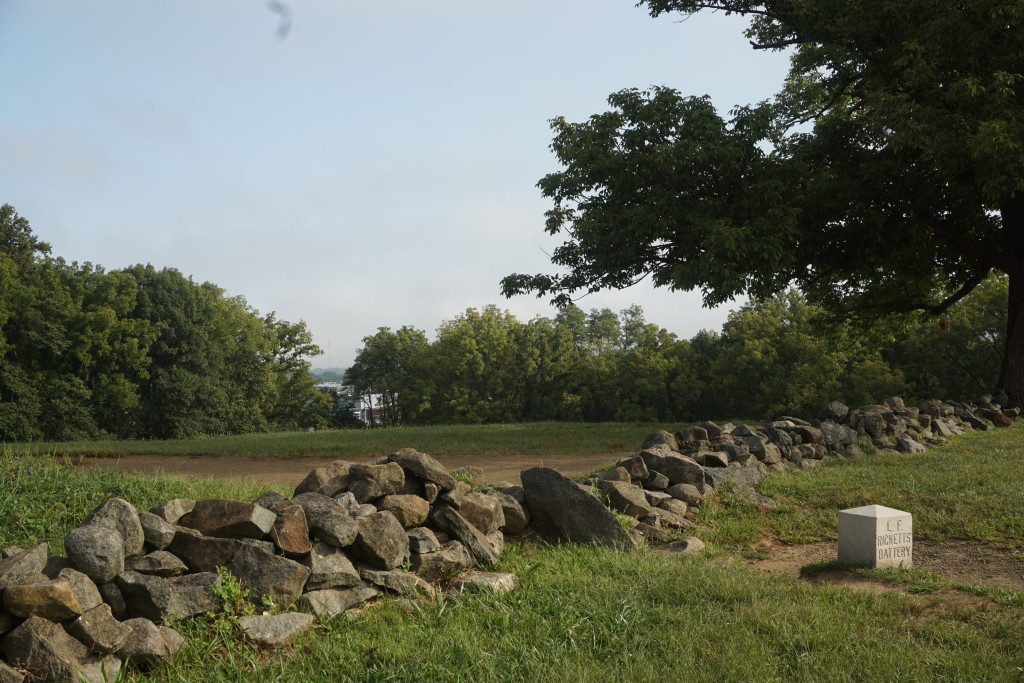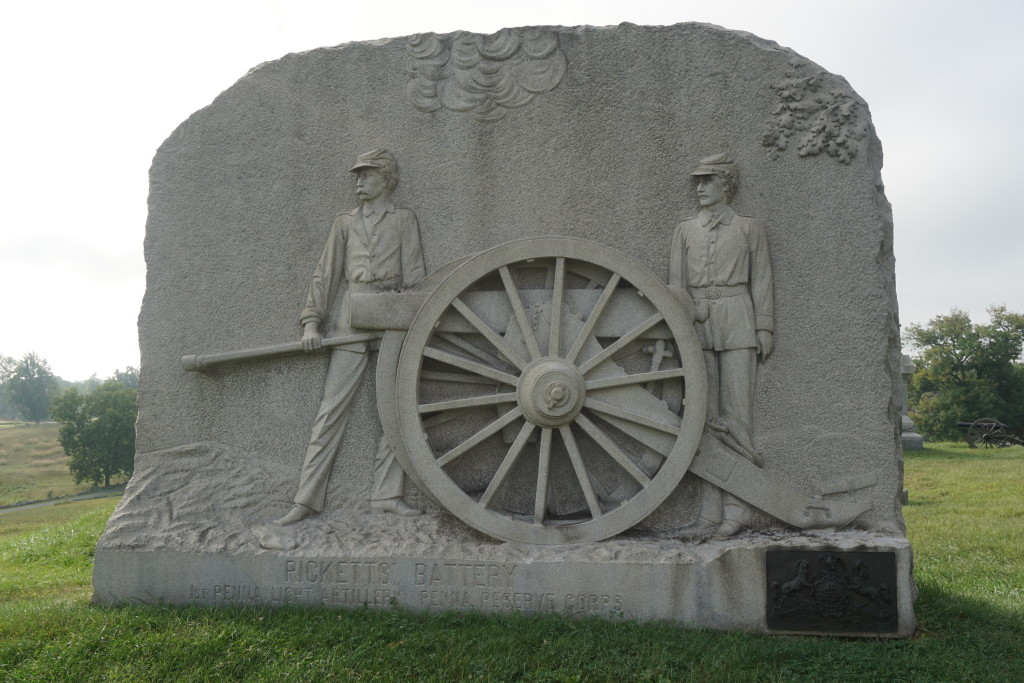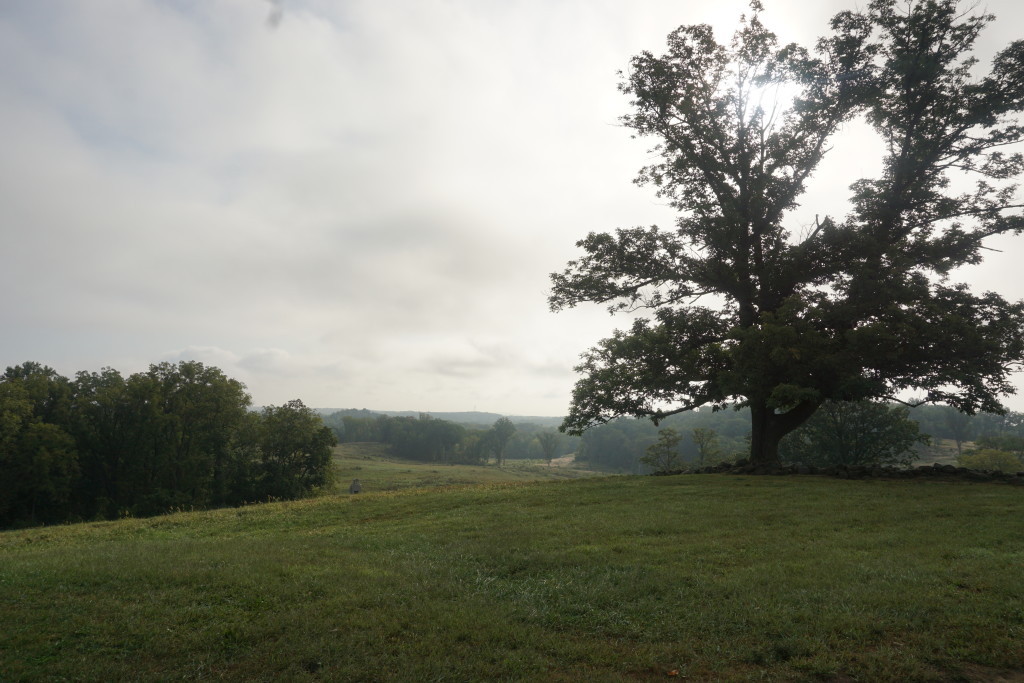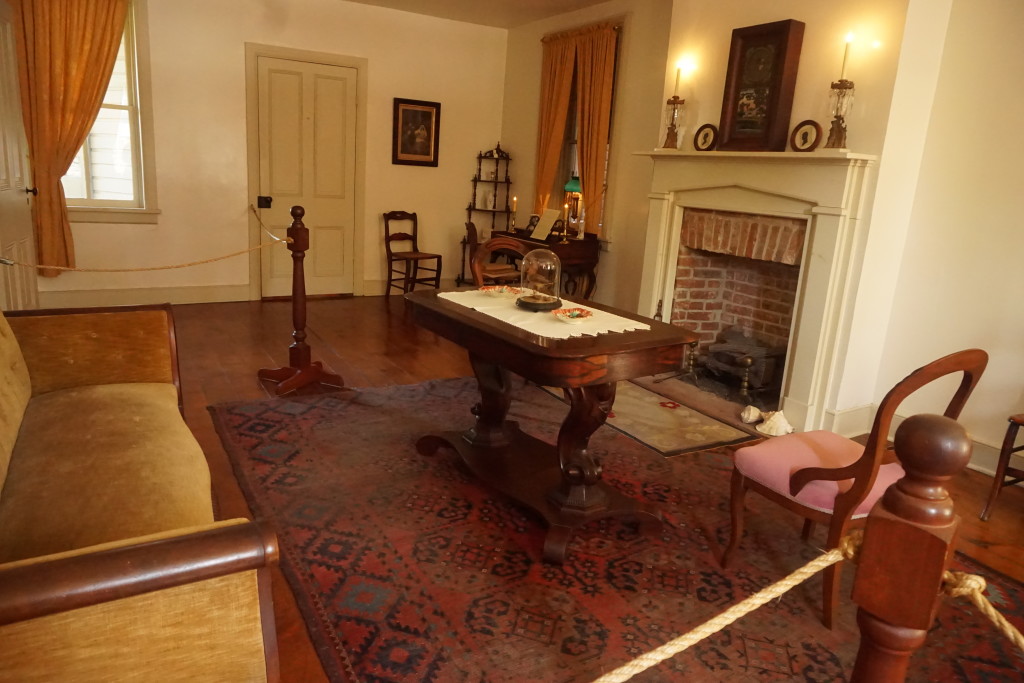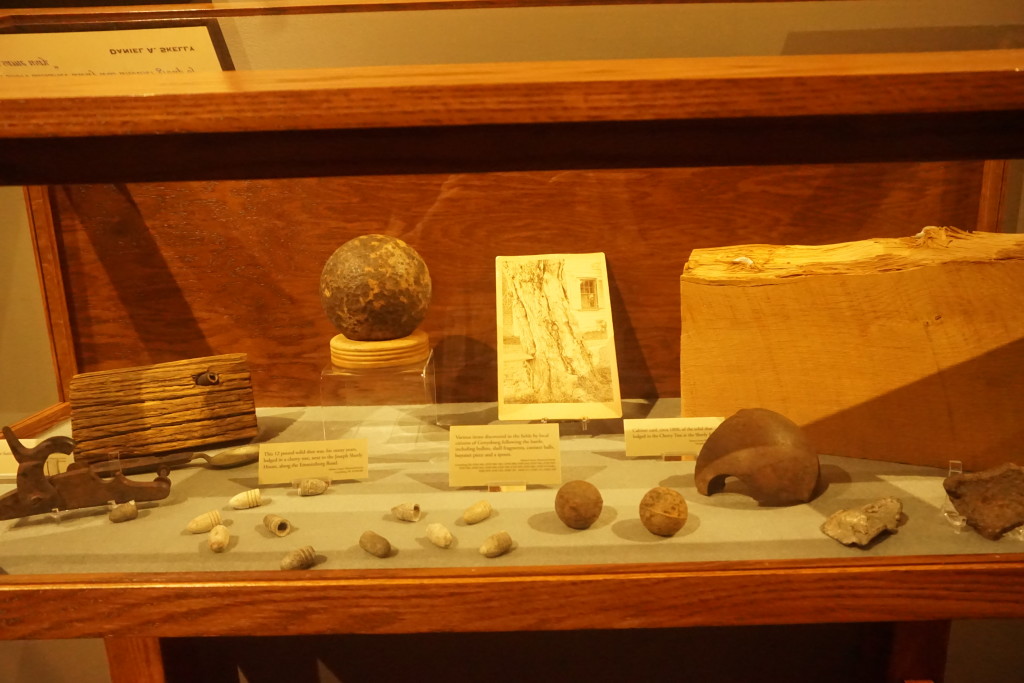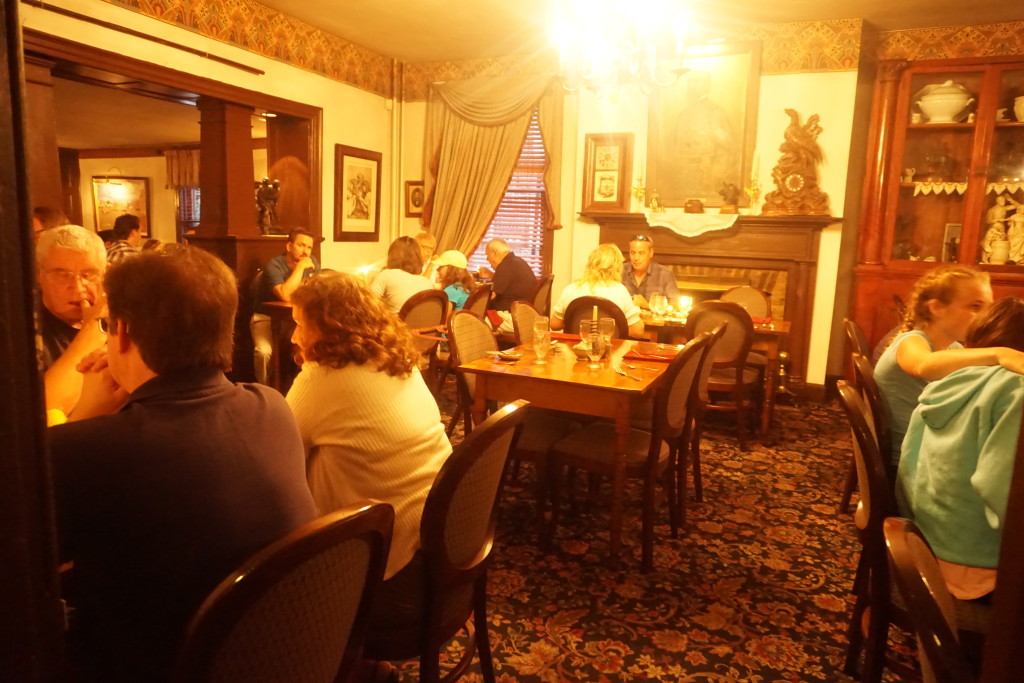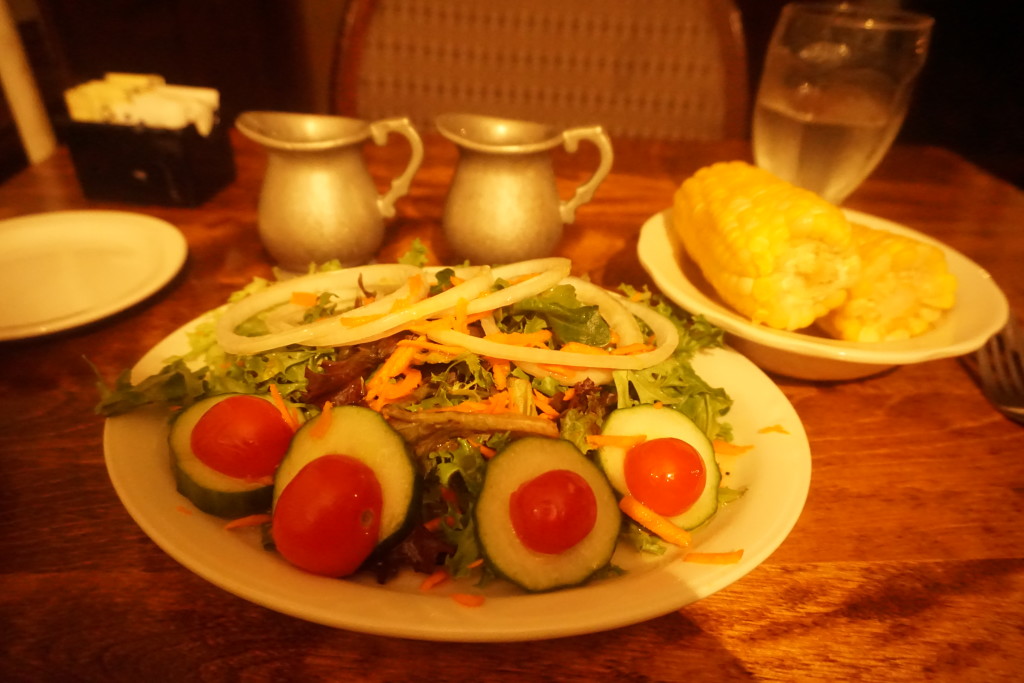I was excited to start my second day of sightseeing in historic Gettysburg, Pennsylvania. Since my stay at the beautiful and chic Gettysburg Hotel included breakfast, I headed downstairs to their onsite restaurant “One Lincoln” (One Lincoln Restaurant). In sync with the local vibe, the restaurant wallpaper pattern actually contains the text of the Gettysburg Address. The bright and cheery restaurant was very accommodating to my vegan meal request. My breakfast started off with a hot oatmeal, accompanied with a bowl of fresh mixed berries.
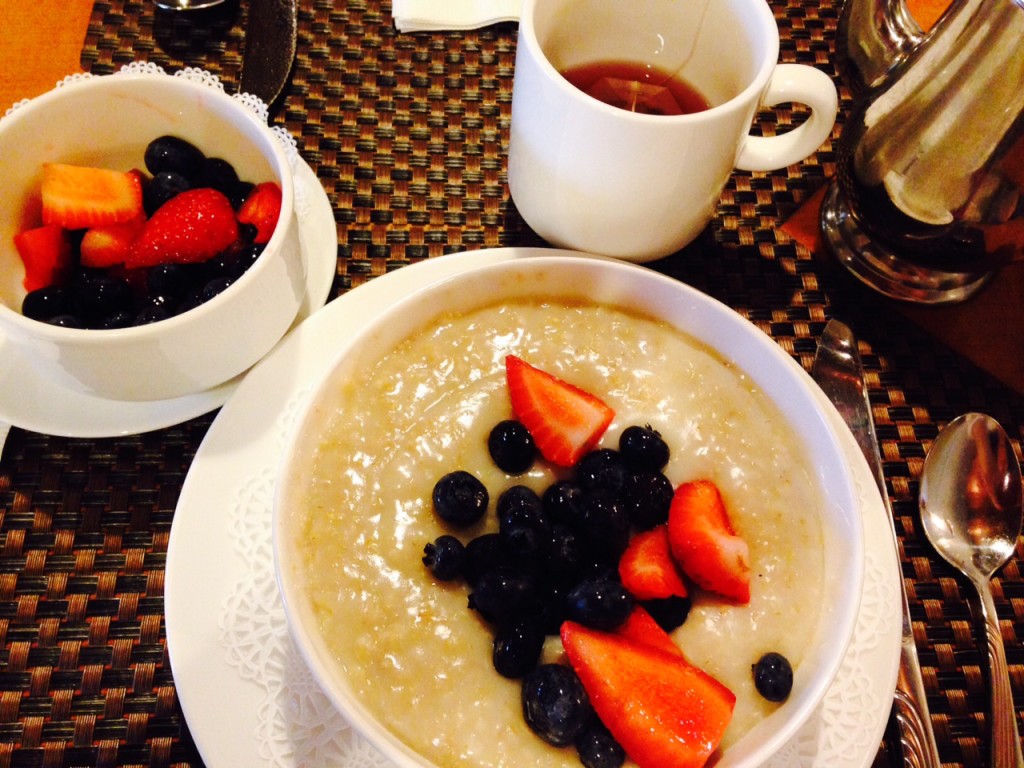
Next arrived a potato hash that included broccoli, mushrooms, tomatoes, onions, and peppers. The veggies were cooked perfectly. I selected a green pomegranate tea to drink. My vegan breakfast was delicious!
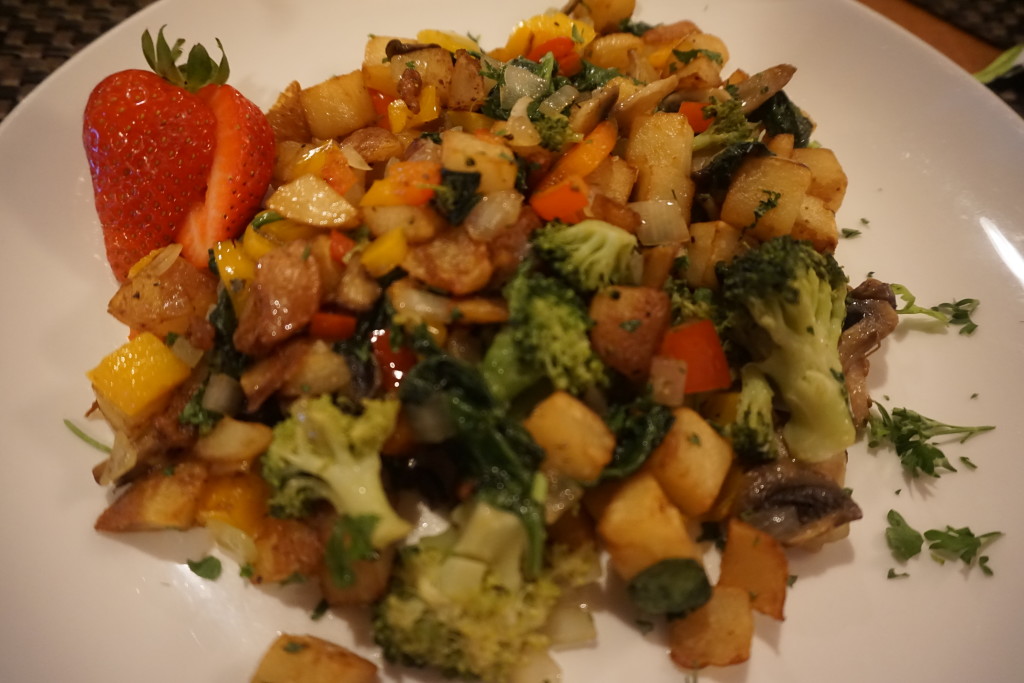
It was time to conquer each of the stops on my day’s itinerary! I planned to first visit Cemetery Hill and the National Cemetery, which was further up the road. This path provided me with many interesting sights to view along the way. I popped into Gettysburg Presbyterian Church for a few moments to see the pew where President Abraham Lincoln sat for a patriotic speech by Charles Anderson, while he was in town to deliver the Gettysburg Address on November 19,1863.
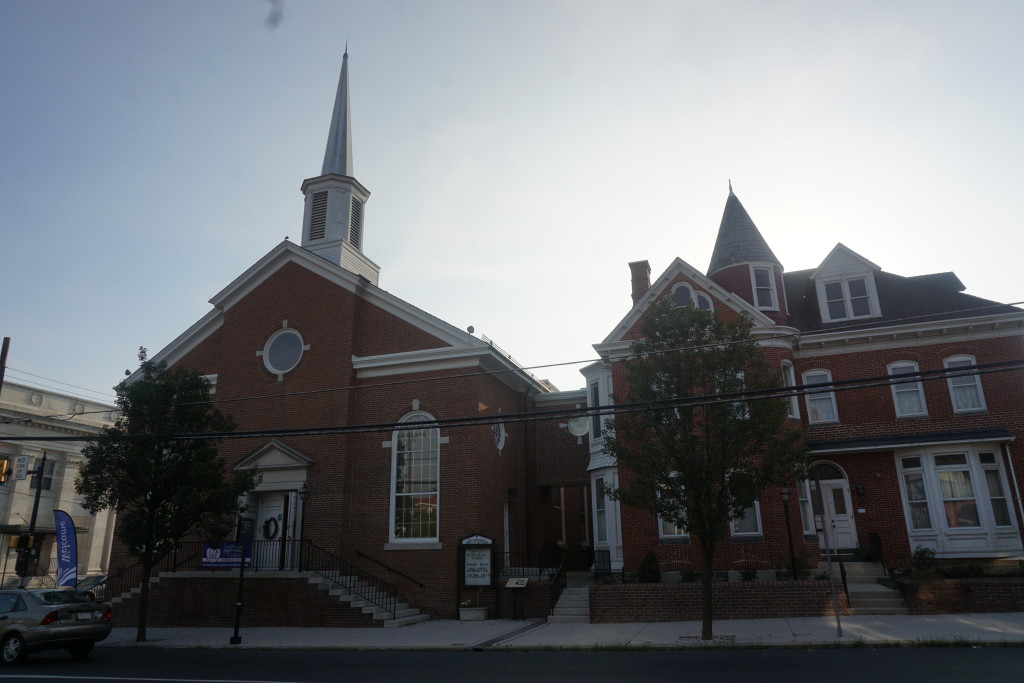
All along the street, Civil War period homes were decorated with red, white, and blue banners. What a patriotic atmosphere and sense of American pride, this creates for locals and tourists alike!
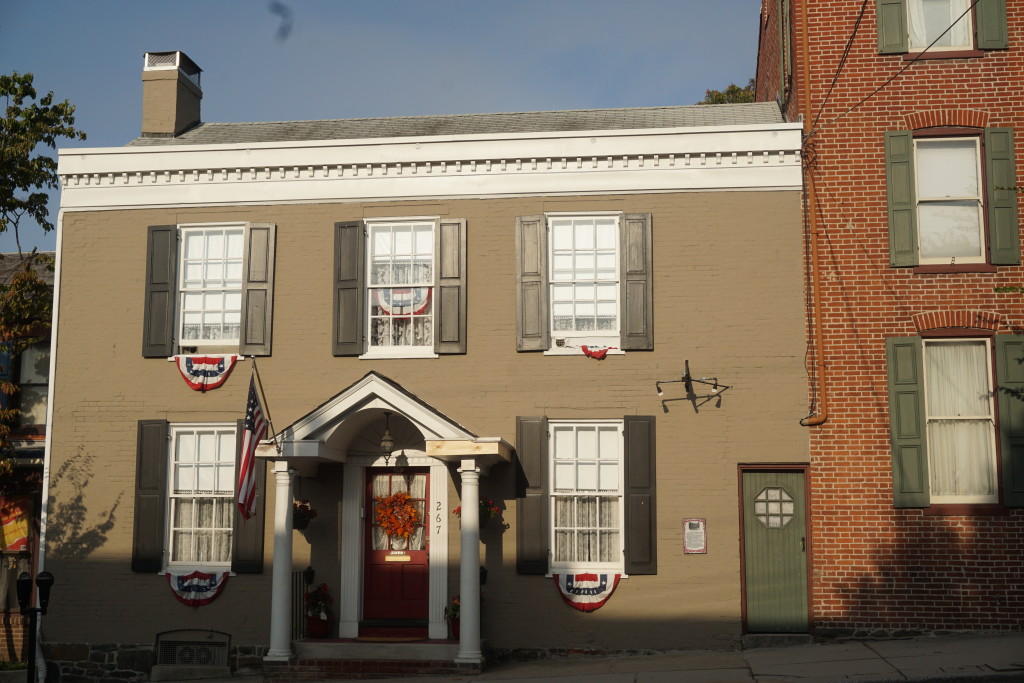
I came across several Civil War Re-enactments around town. The re-enactments typically revolved around the war period makeshift hospitals and camps for the wounded.
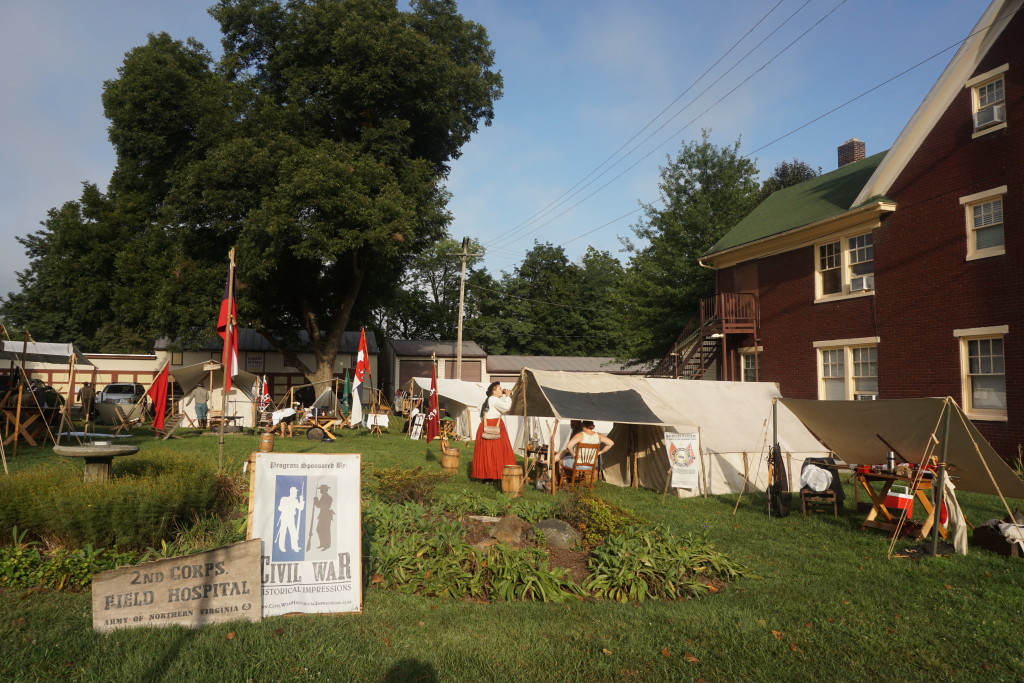
Baltimore Street, one of the main roads in downtown, is also home to many restaurants, museums, and souvenir and gift shops.
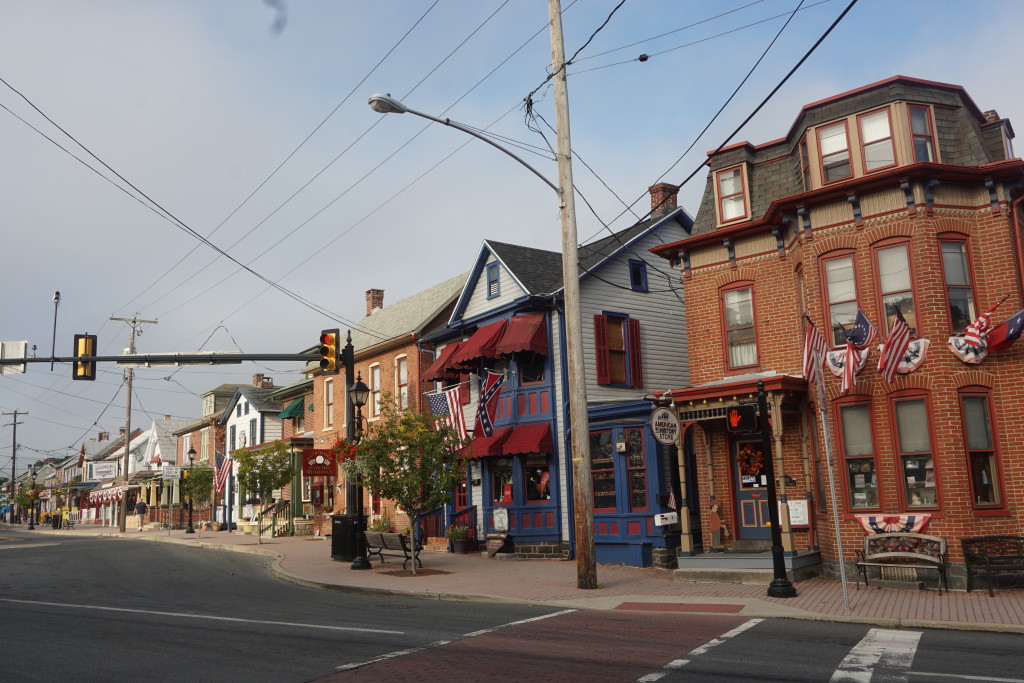
After an invigorating morning walk, I arrived at Cemetery Hill. During the first day of the Battle of Gettysburg, Union forces commander Oliver Howard decided to select East Cemetery Hill as the base for his Eleventh Corps. These days, bronze plaques describing the various battles and troops are found along the grassy field.
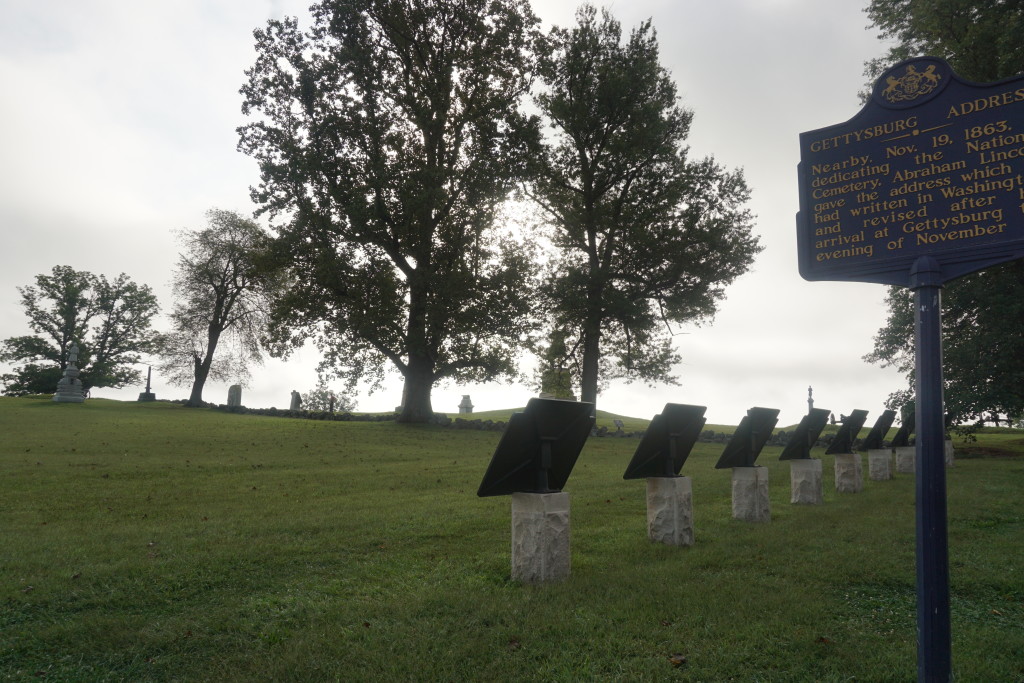
The “Army of the Potomac” plaque is one of the many descriptive signs you will encounter. This corps was the largest Union Army in the eastern region of the Civil War. Major George Meade was its commander during the Battle of Gettysburg.
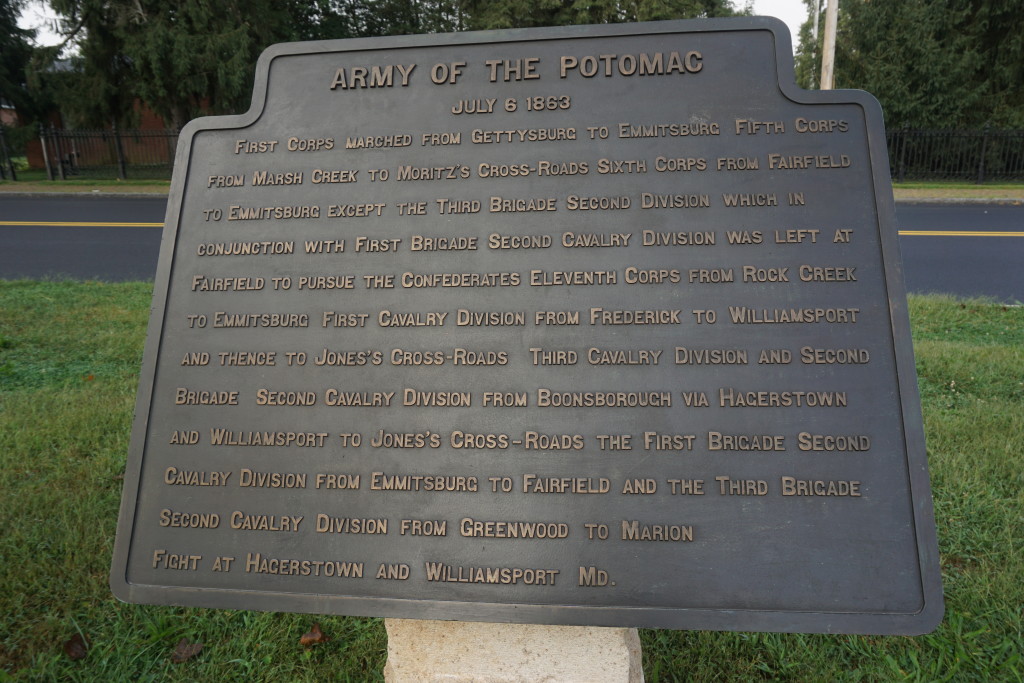
During July 2nd, the second day of the battle, Confederate General Robert E. Lee ordered Leutenant Richard Ewell to attack the Union position. Ewell and his men fired their artillery from Benner’s Hill. A Louisiana brigade under General Harry Hays, along with Colonial Isaac Avery’s North Carolina Brigade, initially pushed back the Union infantry lines. However, Union troops on Culp’s Hill and East Cemetery Hill closed in on the Confederates and destroyed them. During the darkness of night, Confederates attacked and pushed forward, while several cannons from New York’s Weidrich battery and Rickett’s battery fell into their hands. Second and Eleventh Corps Union reinforcements fired artillery that caused a loss of life for Lee’s men and prevented the Confederates from advancing further. The Confederates were outnumbered, forcing Hays and Avery to retreat down the hill and give up those grounds.
A statue of Major Winifred Hancock, who was wounded during Pickett’s Charge, specific battle markers, as well as cannons, now grace those fields.
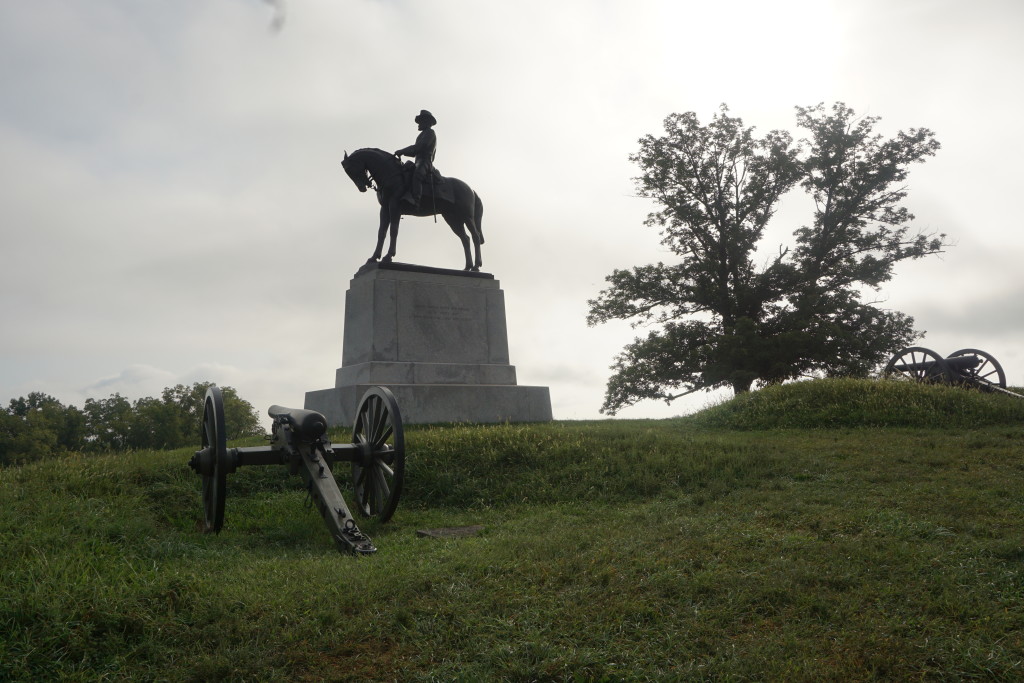
During the afternoon of July 3rd, General Lee attacked the Union center on Cemetery Ridge. The Pickett’s Charge briefly overtook the Union forces, but was eventually pushed back with serious casualties.
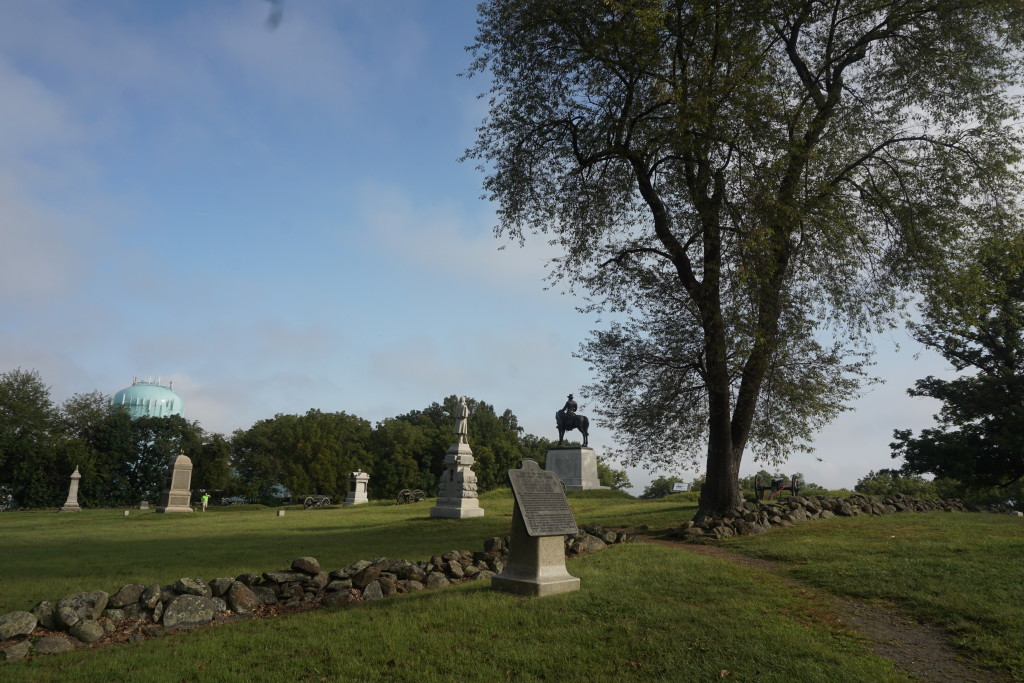
Across the road, the Gettysburg National Cemetery is located. Over thirty five hundred Union soldiers were laid to rest here. Many Union soldiers’ bodies were scattered across the battlefields around town. The governor assembled a committee to develop a cemetery for these war casualties and heroes.
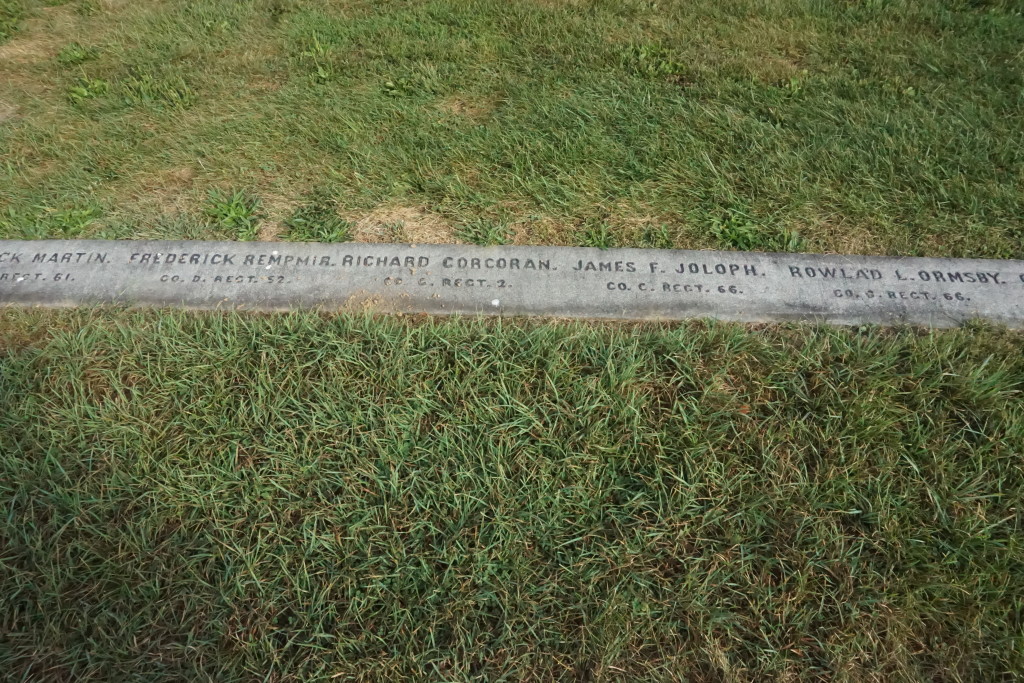
President Lincoln delivered his infamous “Gettysburg Address” speech here, during the cemetery’s dedication ceremonies on November 19, 1863. It is thought that the wooden platform on which he stood, was located near where the National Monument now stands. The statue was erected in 1869. The four small figures on its base represent war, history, plenty, and peace. The statue “Genius of Liberty” resides on the monument’s crown.
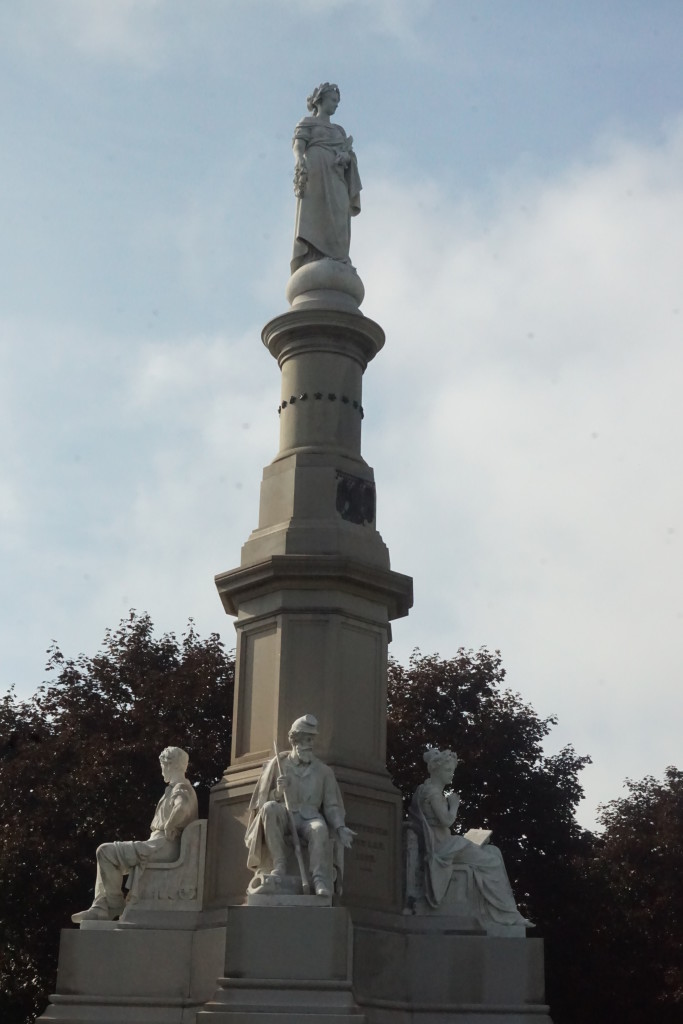
Onward I marched down Baltimore Street towards the Jennie Wade house. She is noted as being the only civilian casualty during the Battle of Gettysburg. Jennie was a twenty year old girl staying at her pregnant sister’s home for safety from the battle.
Unfortunately, she was killed when a stray bullet made its way through two door frames and struck her while she was kneading dough in the kitchen. The floorboard on which she stood, as well as the artillery shell that pierced the roof, are displayed within a glass case in the home.
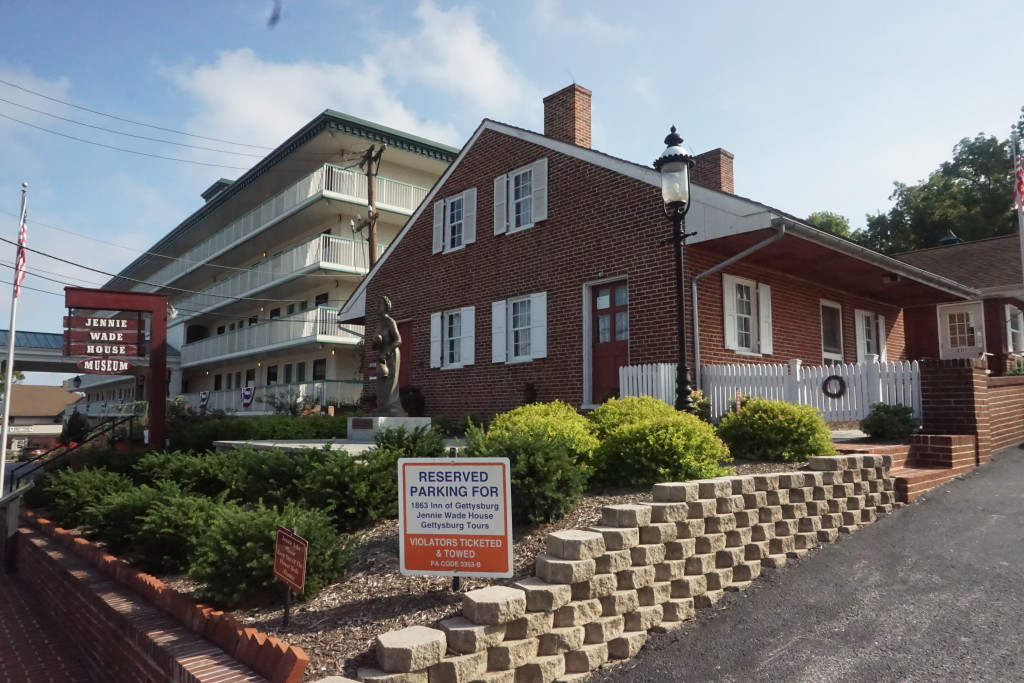
The hole in the door to the right of the guide, is where the bullet entered the home.
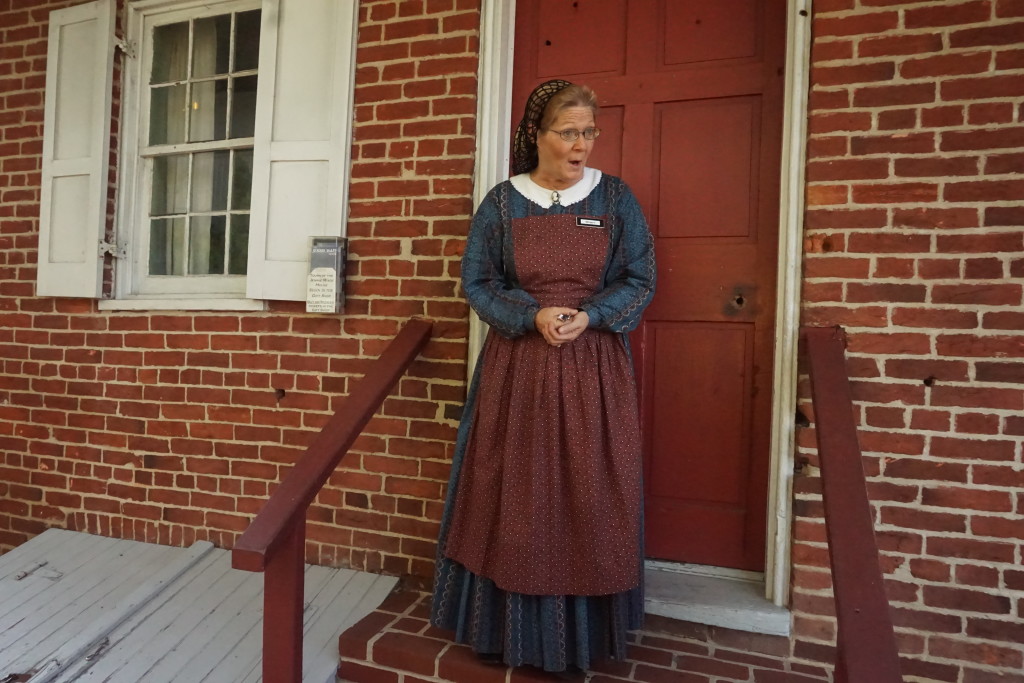
We first toured the bedroom where Jennie helped her pregnant sister.
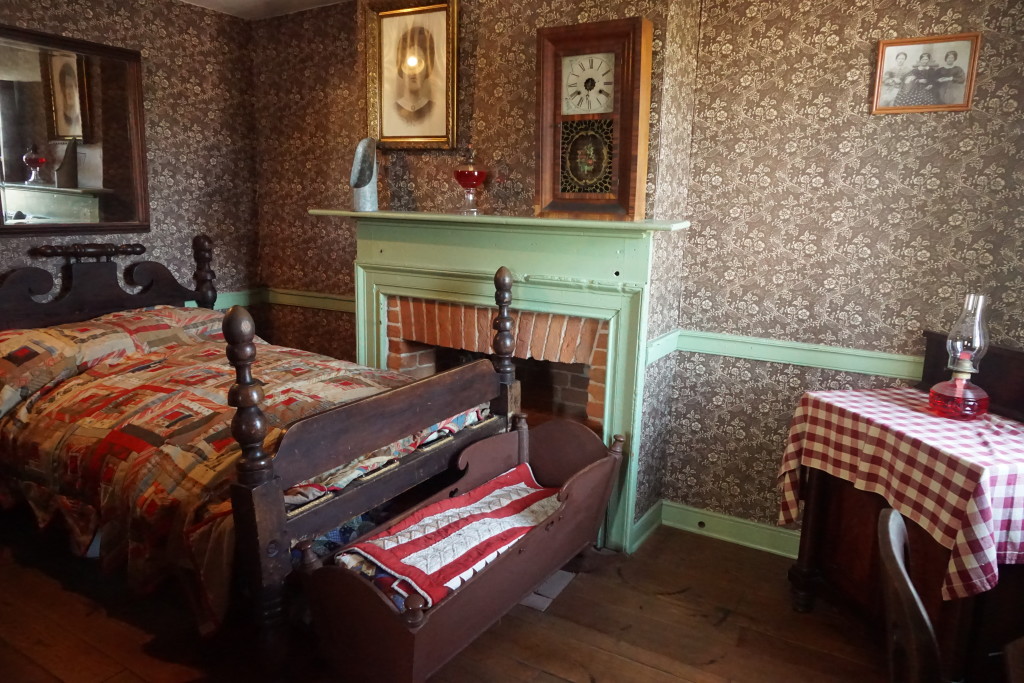
The guide then proceeded to show us the table to her right, where Jennie was kneading dough, prior to getting hit by the stray bullet. A bullet hole is also evident on the interior door directly before the table where she stood that fateful day.
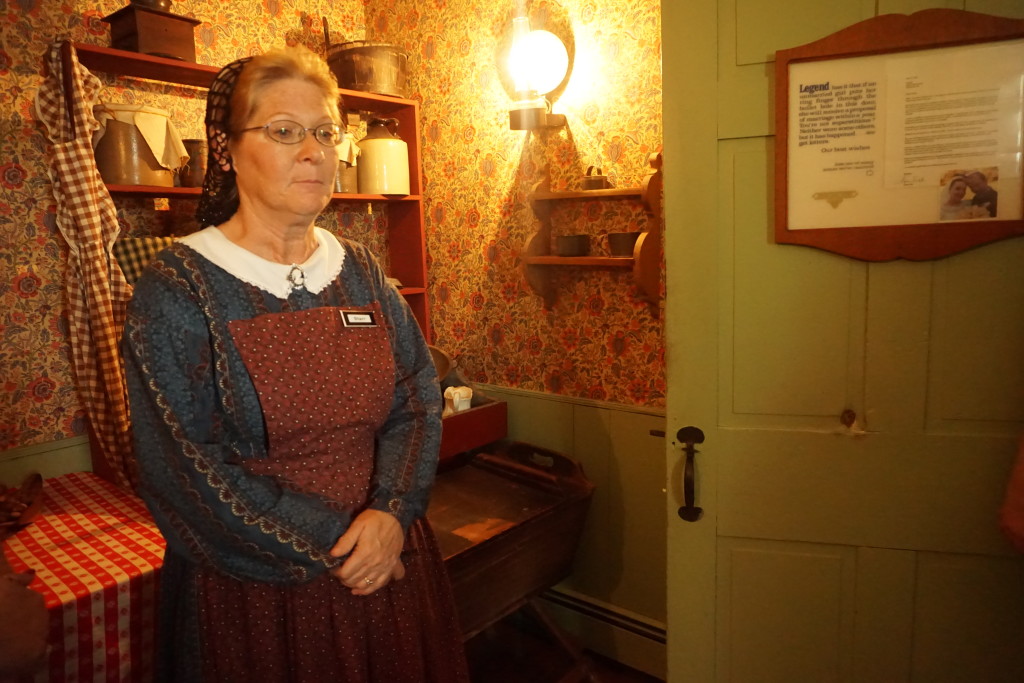
The Shriver House Museum is located further down Baltimore Street. The Civil War home of George Shriver and his family gives tourists a good glimpse into a civilian home from the Civil War period.
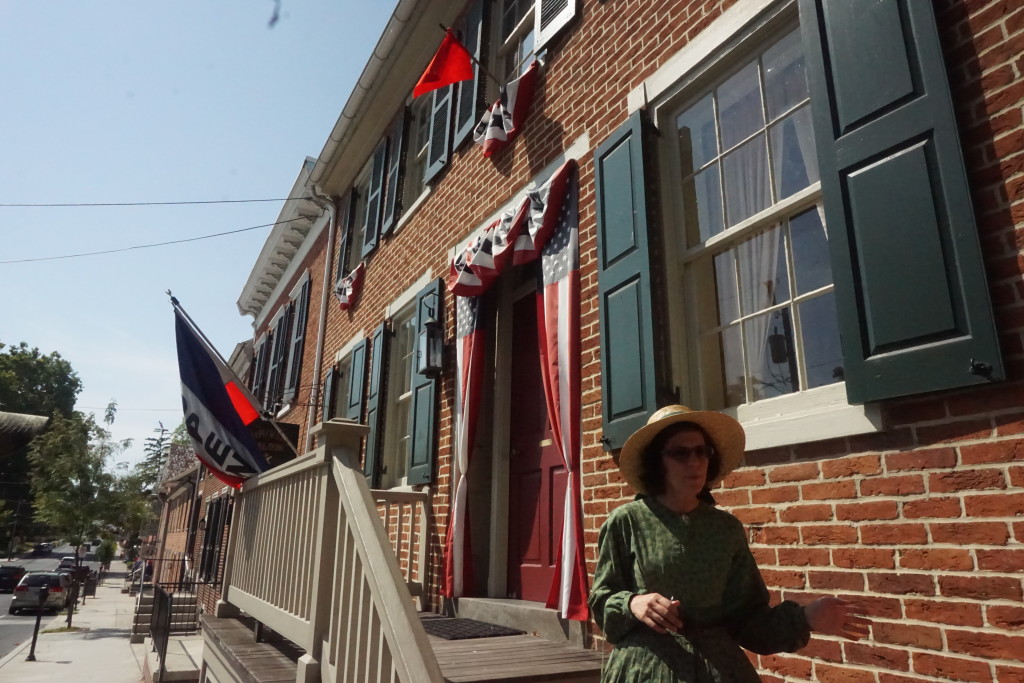
Each room maintains the environment of what it may have resembled during the war and post-war time. Opposing army soldiers invaded Union family homes for easy access to fire their ammunition, and then left them in a messy and dirty condition, with items tossed here and there across the rooms.
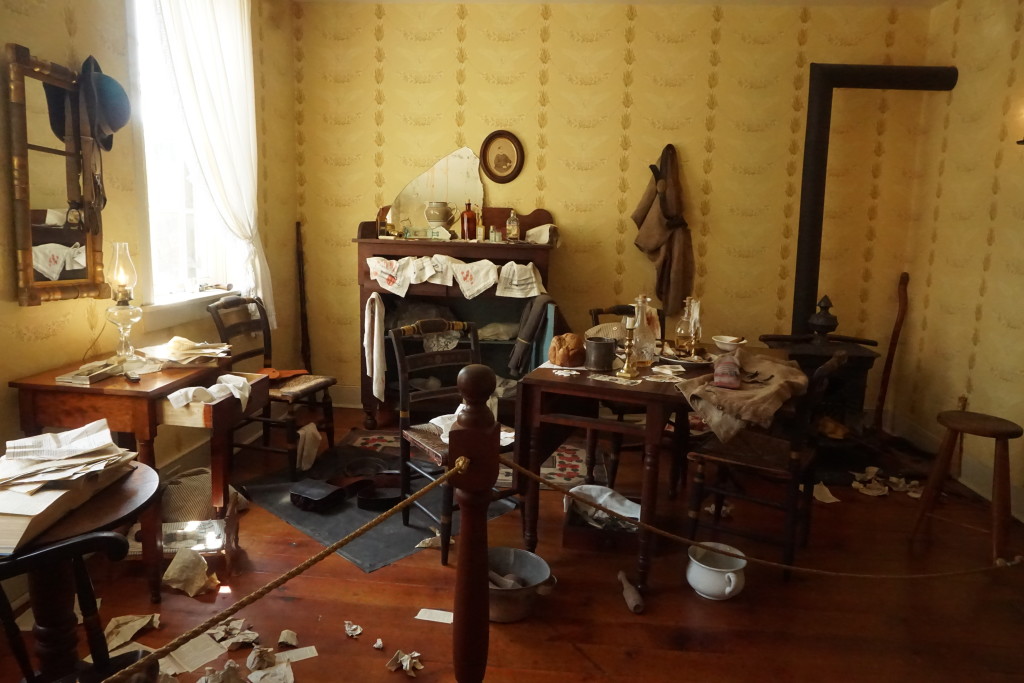
Sharpshooters positioned themselves in the Shriver’s attic to take aim at their targets.
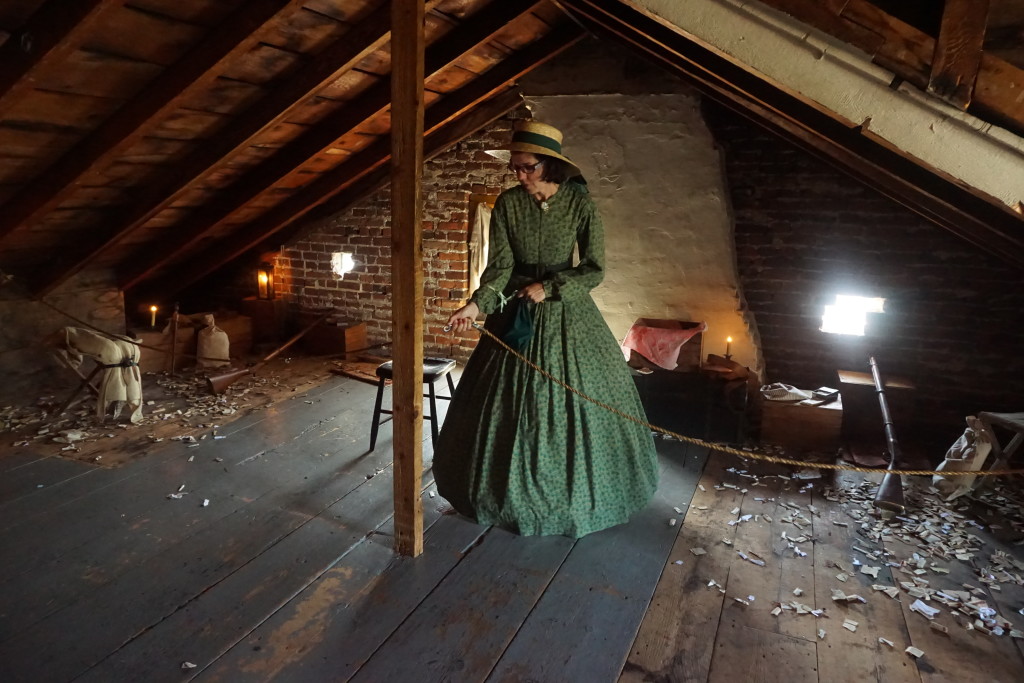
The Shriver basement was used as a makeshift hospital to treat wounded soldiers from either side.
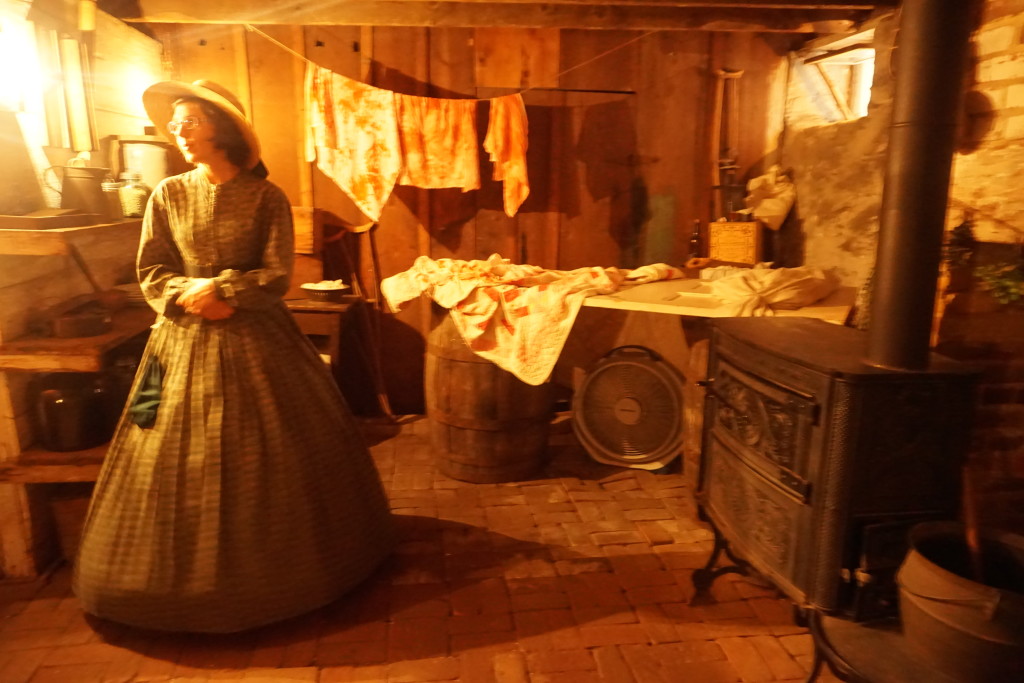
The Shriver’s tavern business also resided in the basement and a bowling alley was located in the back yard.
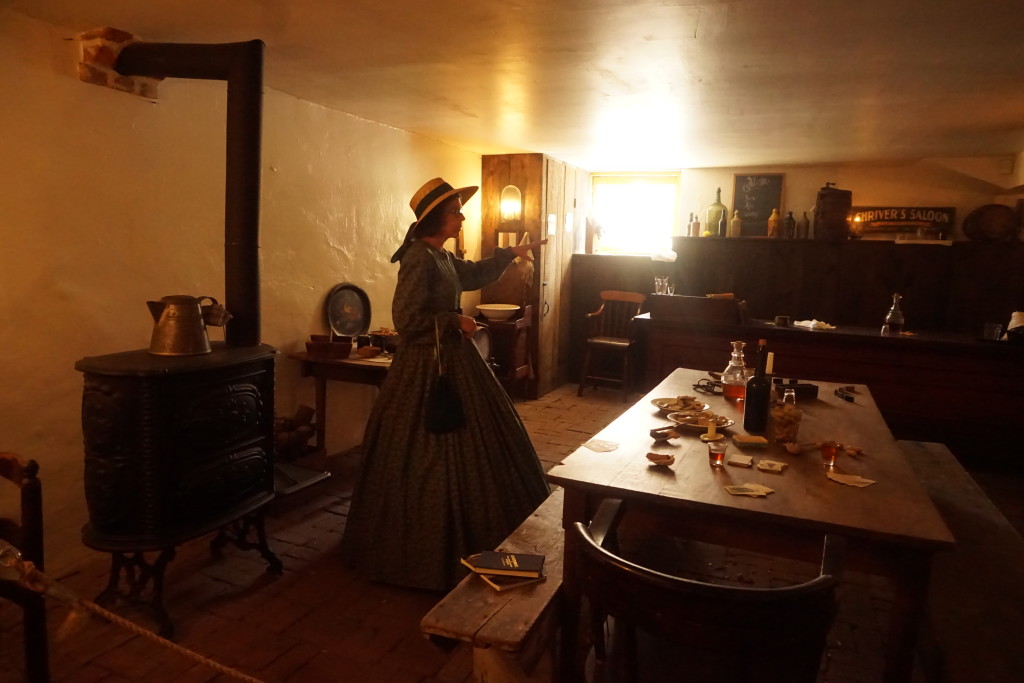
After my busy morning of sightseeing and tours, it was time for a hearty lunch. I continued to stroll down Baltimore Street until I reached Ping’s Cafe (Ping’s Cafe). This vegan-friendly casual restaurant offers several vegan items listed under their “vegetetabe menu”. The kitchen is also willing to cater to their vegan diners. In my case, the entree I selected was the bean curd with vegetables which contained fried tofu. However, they kindly changed it to steamed, per my request. My lunch was a steamed tofu dish with green beans, asparagus, snow peas, broccoli, peppers, carrots, tomato, and mushrooms in a brown sauce. It was accompanied by steamed rice and a lemonade. The meal was very flavorful and reasonably priced.
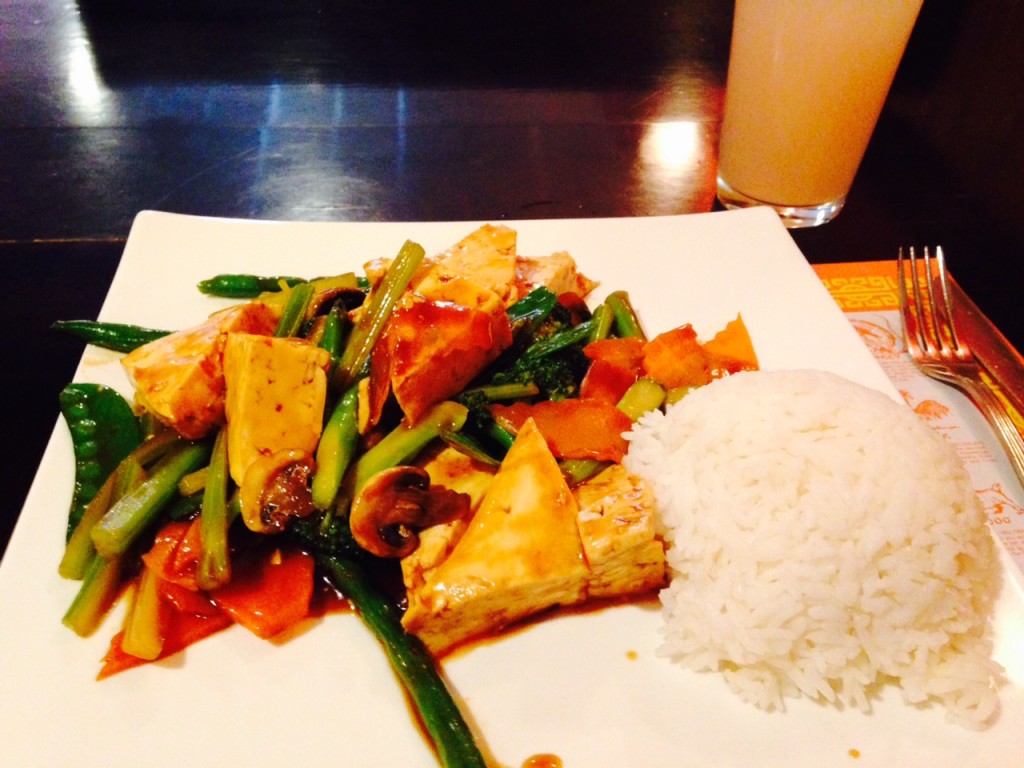
A five minute stroll down the street led me to the David Wills House. He was a prominent figure during Civil War period Gettysburg. Mr. Wills was an attorney, judge, and president of Gettysburg Borough Council. After the 1863 battle, he opened his home for local nurses to take care of wounded soldiers. The U.S. Marshall’s office used the home as their headquarters, as locals would gather here to discuss burial of the war dead. Mr. Wills is credited for suggesting to then Pennsylvania Governor Curtin that a National Cemetery is needed to properly bury those who lost their lives during the war. President Abraham Lincoln completed his Gettysburg Address, while staying overnight at the Wills house prior to the National Soldier’s Cemetery dedication ceremony.
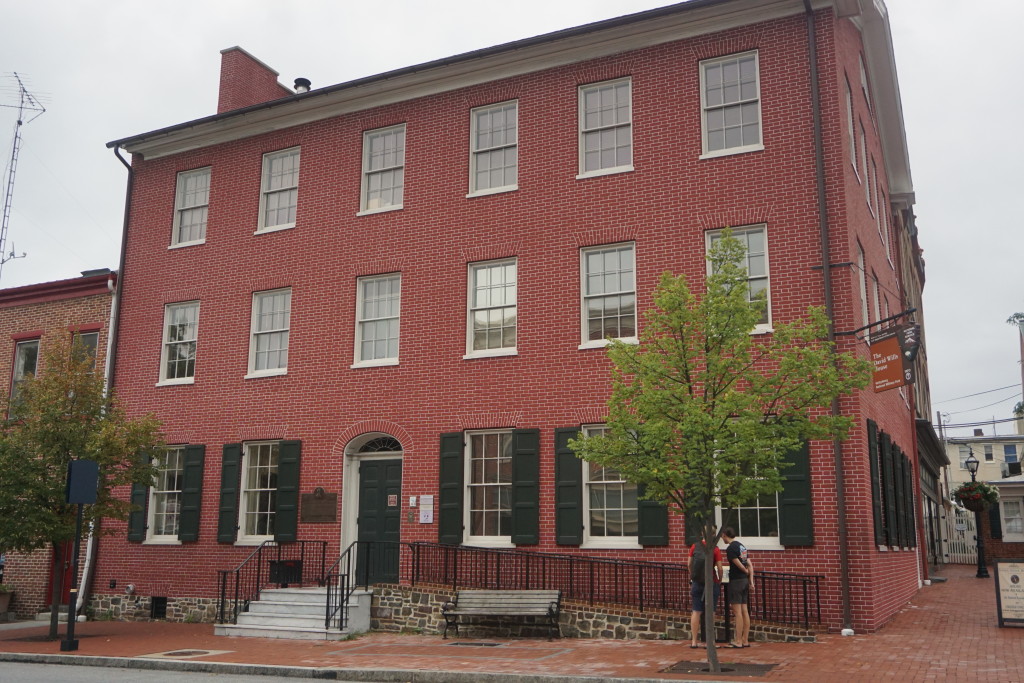
The bedroom where Lincoln slept is on display in the home, with its original furniture.
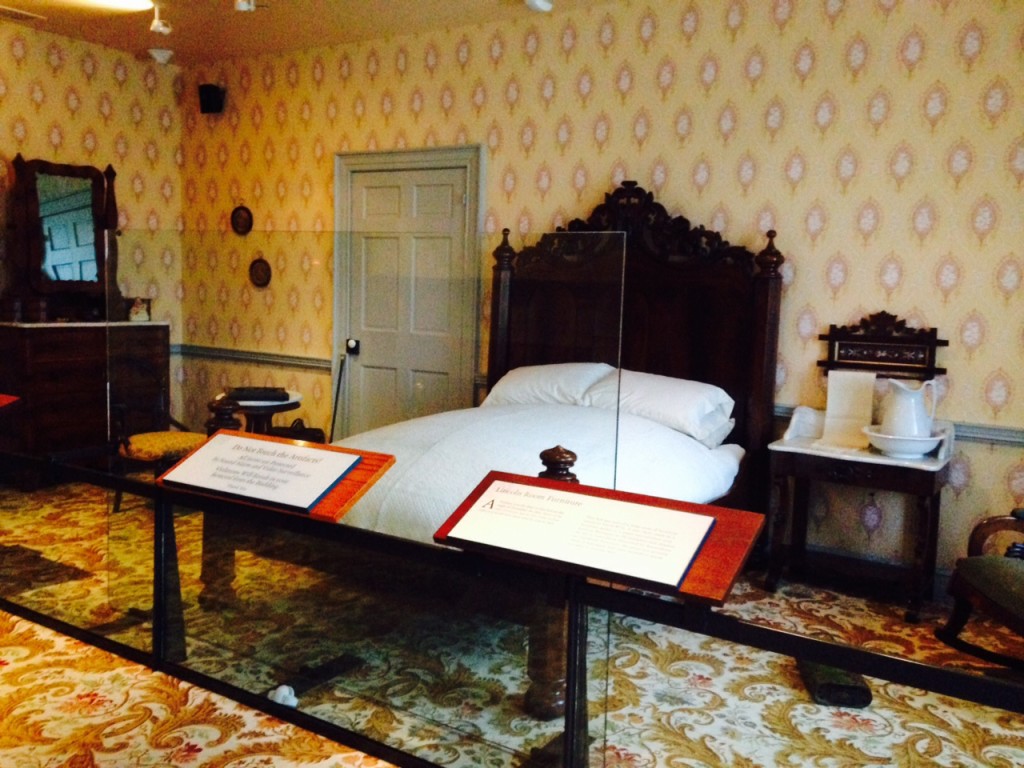
A leisurely twenty five minute stroll brought me to the Seminary Ridge Museum, the next destination on my itinerary. The museum features exhibits focusing on the first day of the Battle of Gettysburg on Seminary Ridge, the care of the war wounded in Schmucker Hall which was utilized as a war hospital, and the moral/spiritual debates of the war.
Prior to arriving at the museum, another noted building appears along our path. Reverend Samuel Schmucker was the founder of the Lutheran Theological Seminary. His home, built in 1833, is also located on these grounds. Schmucker was an ardent abolitionist and was said to have aided the underground railroad in the area, as his residence was used as a stop.
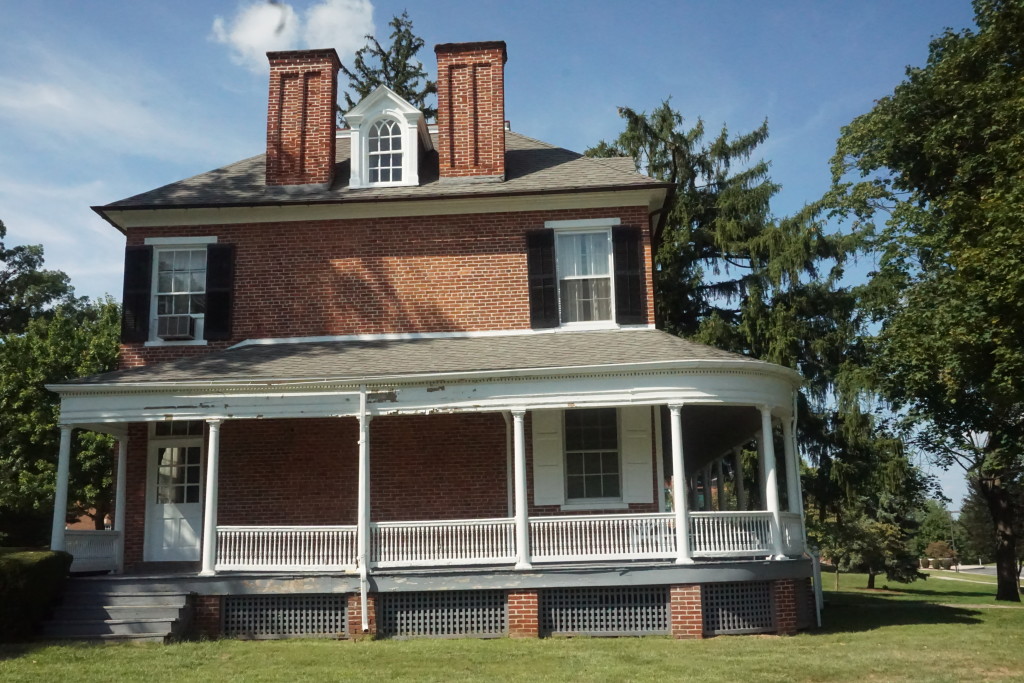
An artillery shell from the Civil War battle still remains lodged in the side of his residence.
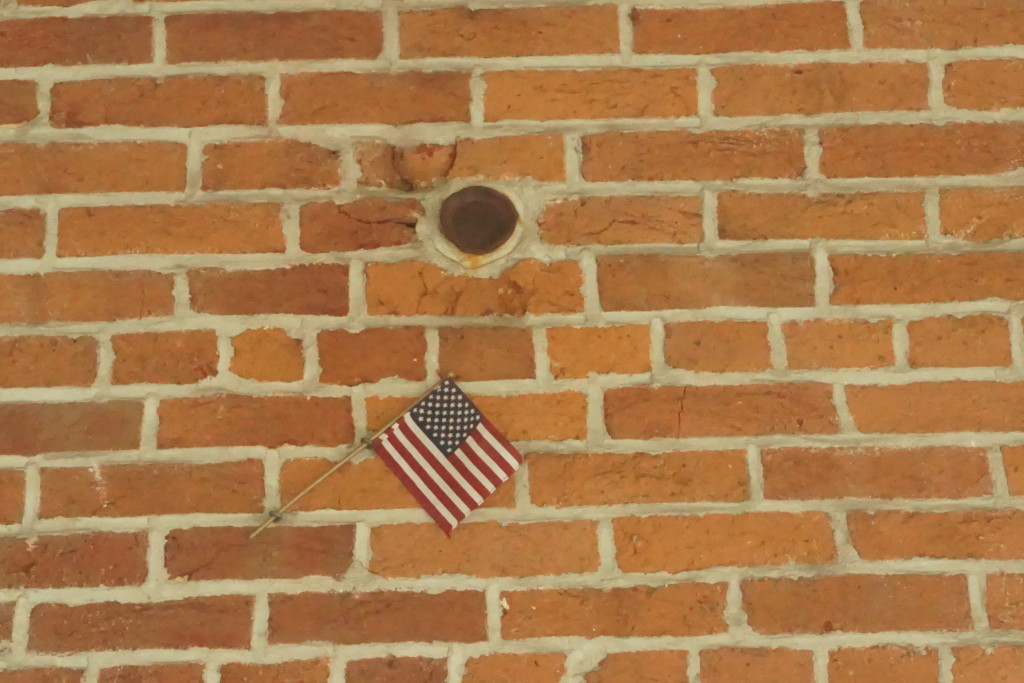
Seminary Ridge was a location that the U.S. Army used for defense during the first day of the battle. The Confederates used the area as an artillery position during the battle’s second and third days. Union leaders would ascend to the cupola of the Schmucker building to lookout for the enemy corps approaching.
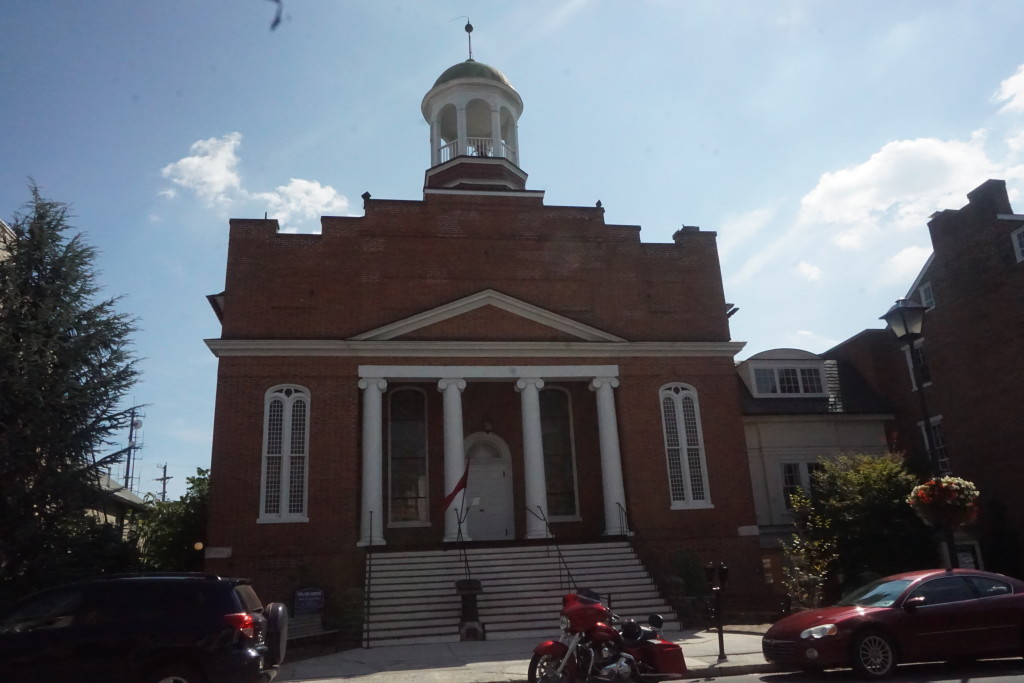
Within the museum, I examined the religious documents and Scripture passages that the steadfast Christian soldiers and leaders would ponder over and debate, regarding the morality of the Civil War. Diary entries and other documents from various preachers and leaders of the time differed in their opinions regarding the moral and spiritual correctness of the war and of the issue of slavery. Original bibles that the soldiers carried on their person, are on display. The museum is definitely worth a visit!
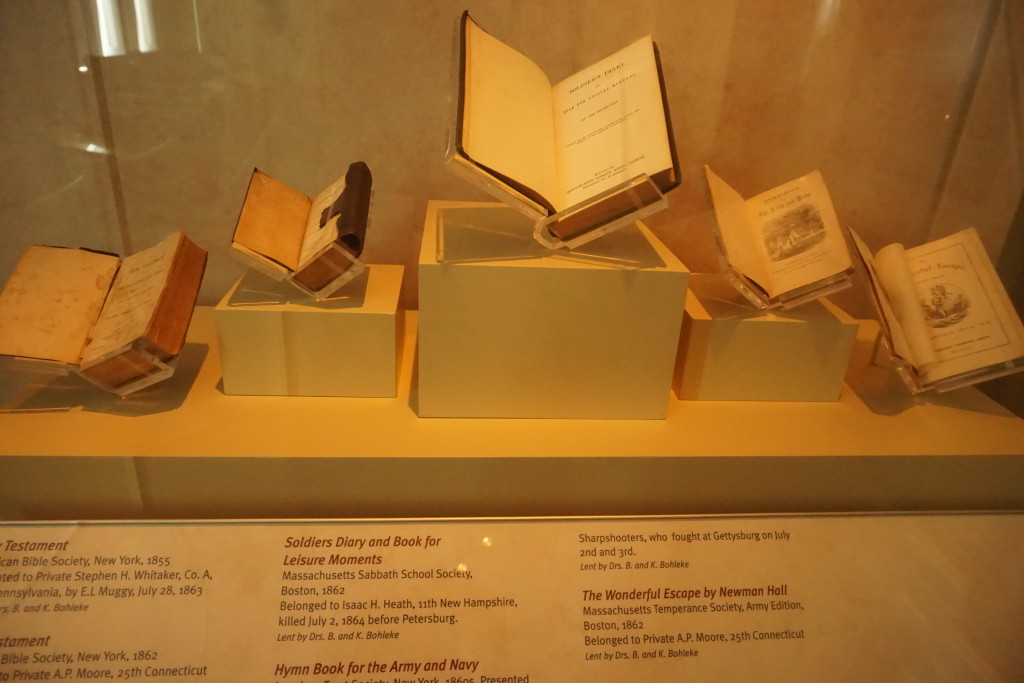
Several exhibits showed the type of surgical tools and equipment used during that time. A wooden leg cast for injured soldiers is viewed behind a glass case.
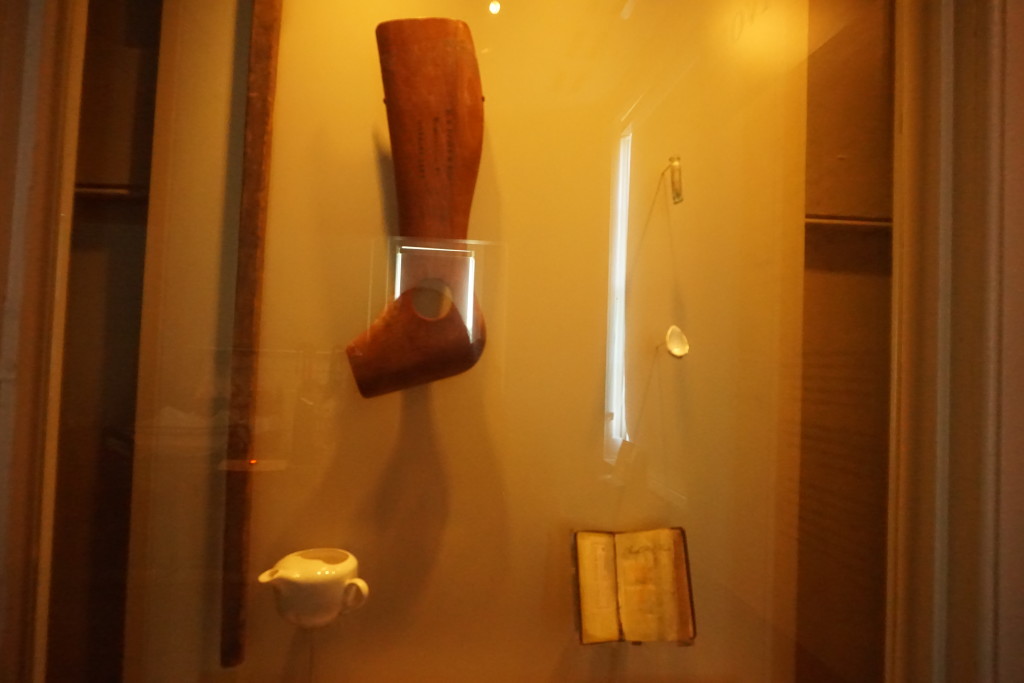
Surgical tools for repairing broken limbs or for performing amputations are on exhibit here as well.
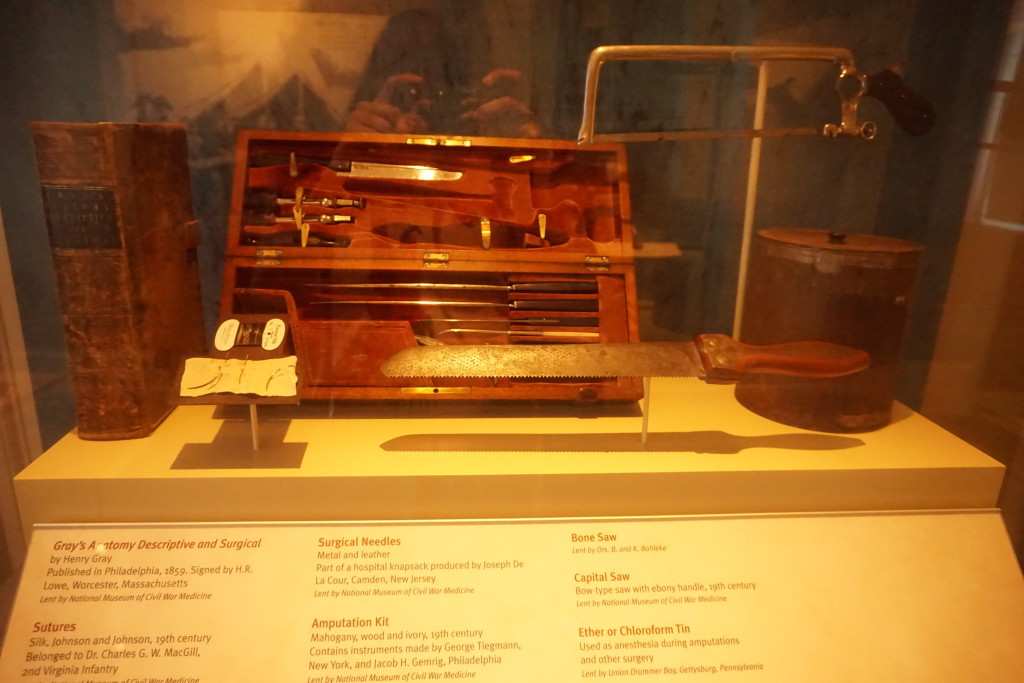
Additional exhibits and interactive displays examined a day in the life of those at the war time hospital and of the first day’s battle at Seminary Ridge.
As I picked up my pace to get back to town, I came across a few more Civil War camp re-enactments. The staff, dressed in period attire, would respond to any questions that an inquisitive tourist may pose of them.
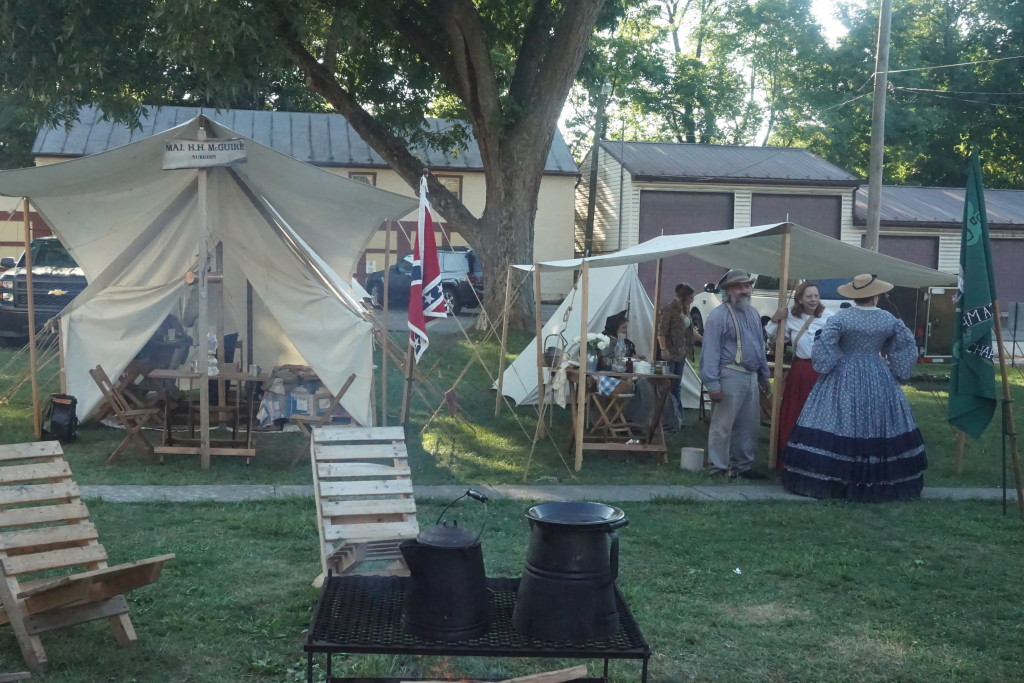
Back on Baltimore Street, I stumbled upon the home where Union general John Reynolds was brought by aides, after he was shot and killed during the first day of the battle.
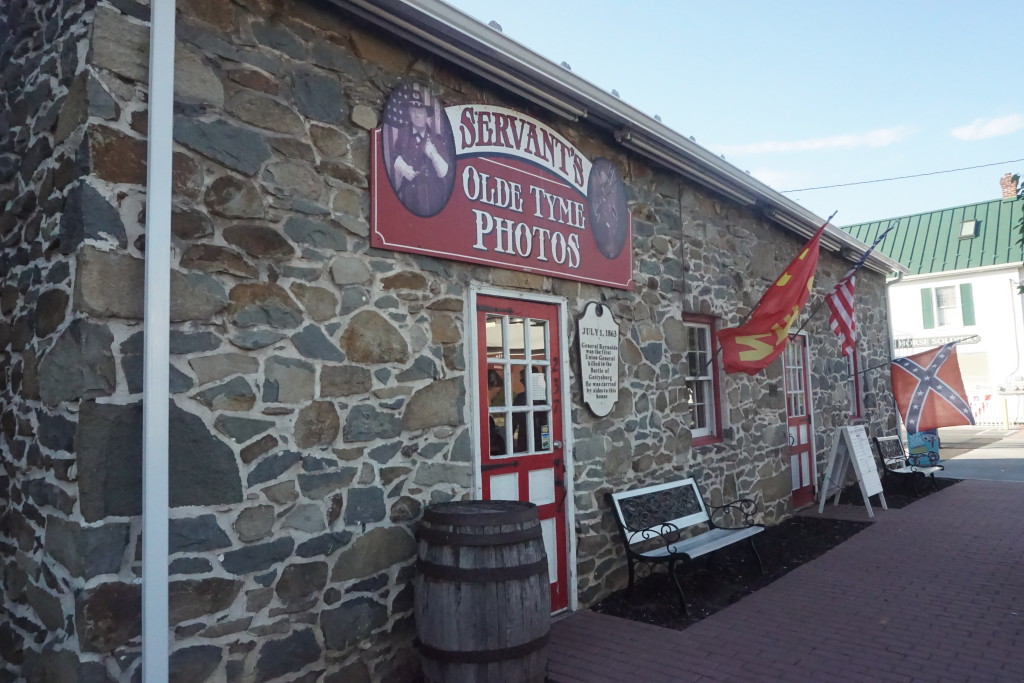
The final stop on my day’s schedule was the Gettysburg Heritage Center. This museum tells the stories of the local citizens and their reactions to the war around them. Recreations of various scenes about the town tells how they lived during those difficult times. 3D glasses are provided to fully encounter the experiences of the people of Gettysburg. Historical documents and excavated items such as bullet-ridden tree trunks and mortar shells from the war, are on display to tell their stories.
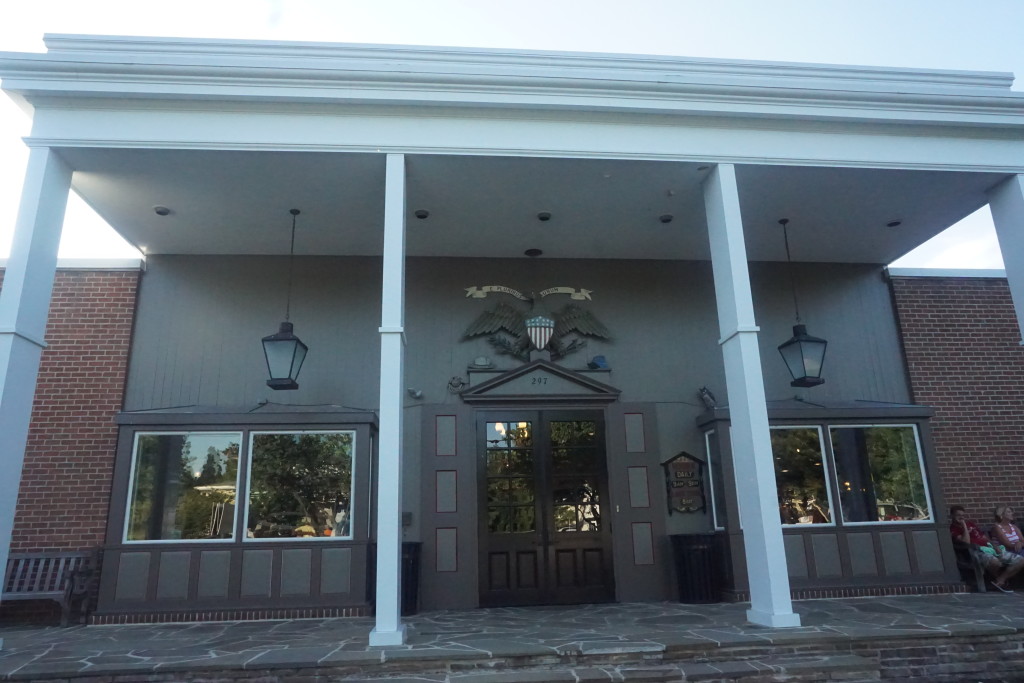
John Burns was a 69 year old Gettysburg farmer who joined the battle on the spur of the moment. It is said that he grabbed his musket and powder horn and walked onto the battlefield. He fought alongside the Iron Brigade at McPherson’s Ride. Mr. Burns was a good sharpshooter, but eventually was injured. He lived to became quite a famous war hero. President Lincoln requested that he join him at the Wills residence and walk with him to attend a speech at the Presbyterian church on the day of the Gettysburg Address. An exhibit in the museum recreates a scene with Mr. Burns.
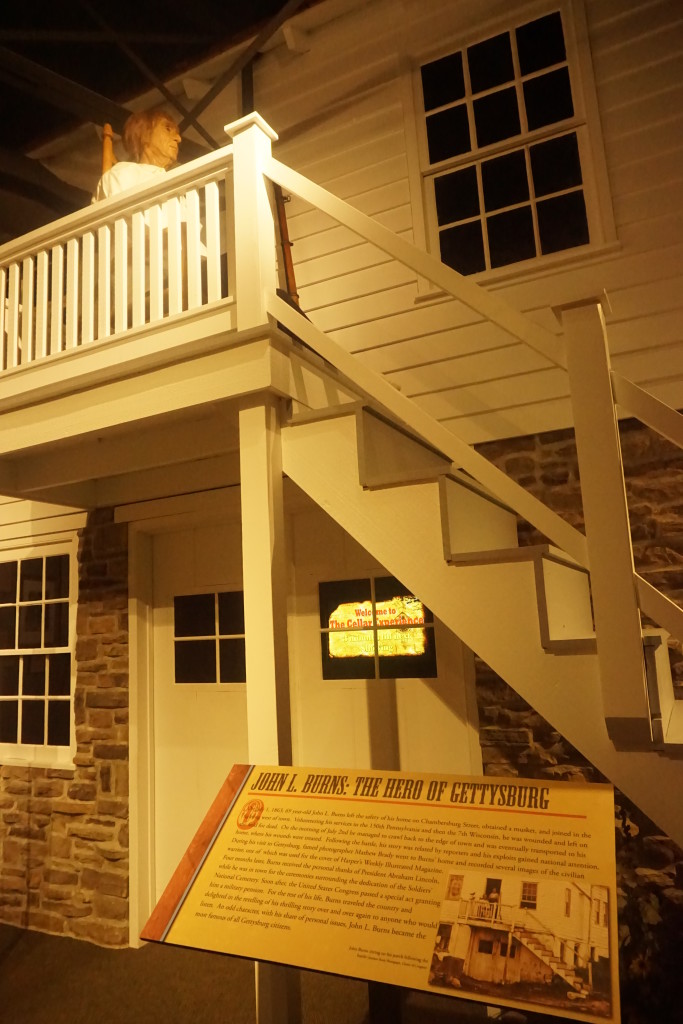
As I headed back up Baltimore Street, I made a stop at “Hunt’s Battlefield Fries and Cafe” (Hunt’s Battlefield Fries and Cafe) after I noticed a sign on the street mentioning their homemade orange and lemon juices. My orangeade beverage was tasty and refreshing.
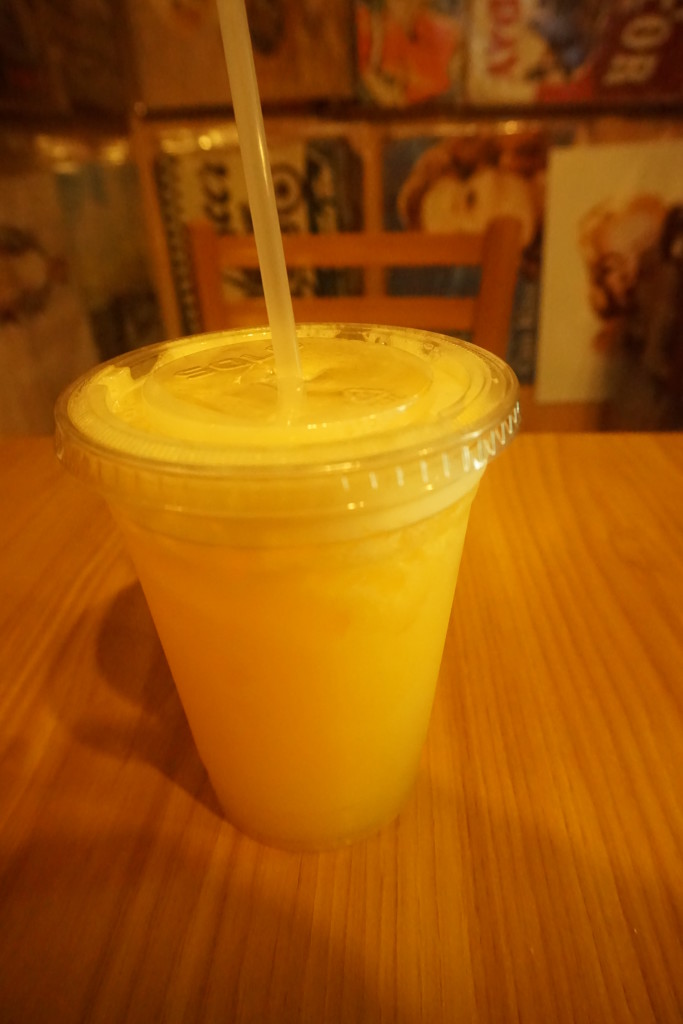
Evening had arrived and so had dinner time. I decided to dine at the historic Farnsworth Inn House (Farnsworth House Inn Restaurant). Its named for Civil War Union general John Farnsworth. He had led an unsuccessful charge, after the failure at Pickett’s Charge, and he lost his life with 65 of his men. Confederate sharpshooters occupied the home at one point. It is thought to be the place from where the shots were fired that accidentally hit Jennie Wade when the stray bullets entered her home down the street. A Civil War period dining experience awaits guests each evening. Waitstaff dressed in period attire serve diners in the Victorian era dining rooms, serving Pennsylvania Dutch and period fare.
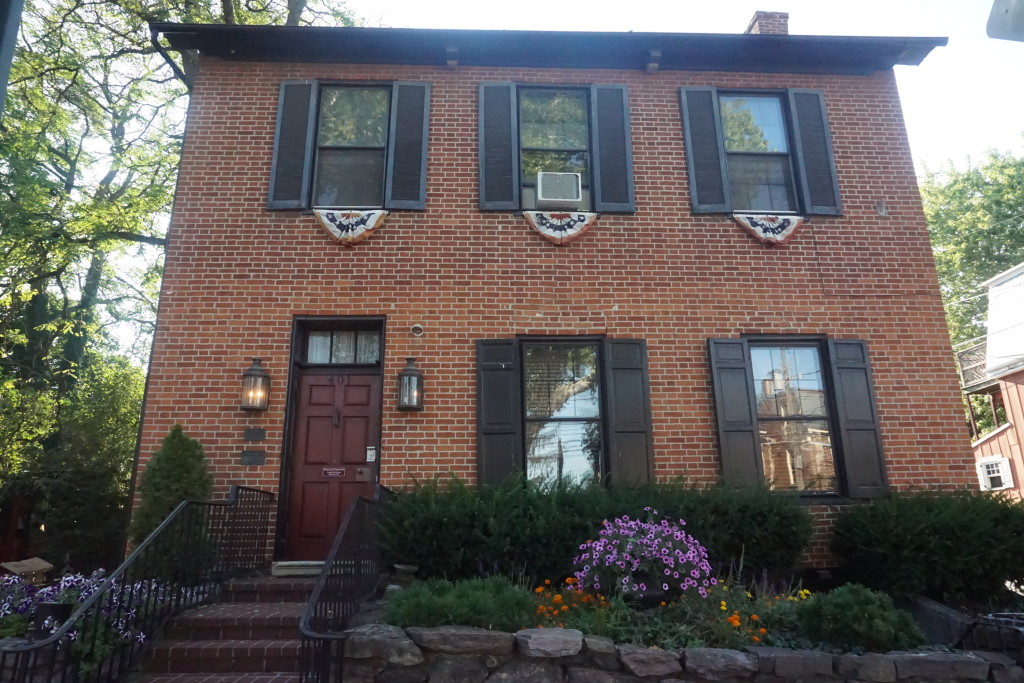
The restaurant did not offer any vegan entrees. However, I still desired to dine there because of the historic relevance and the inn’s ambiance. The helpful waitstaff checked with kitchen and was able to provide me with a meal of corn on the cob(without butter), a large salad, apple butter, and pickled watermelon rind. My dinner was good and filling.
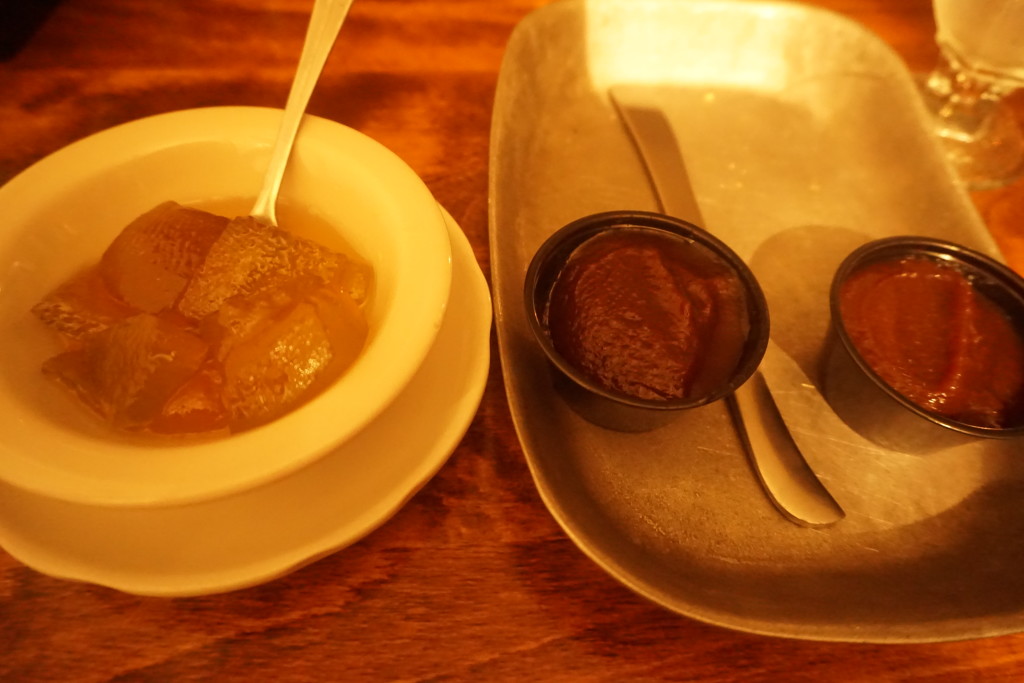
The next morning, I headed to the Ragged Edge Coffeehouse (Ragged Edge Coffeehouse) for breakfast. I opted for the cinnamon raisin bagel topped with homemade peanut butter. It was really yummy! My beverage was the really good “Classic Juice” made with fresh carrots, oranges, and apples.
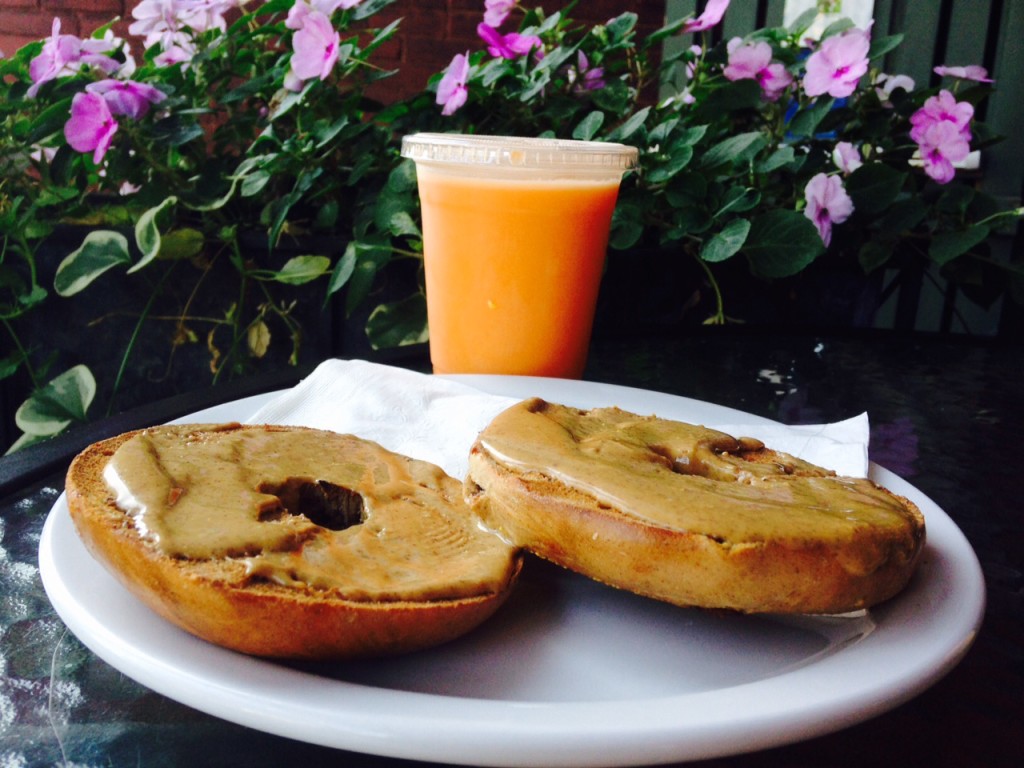
My weekend getaway to Gettysburg, Pennsylvania had come to an end and it was time to head home to Boston. I glanced back at the beautiful Gettysburg Hotel as we drove away, filled with happy memories of my time in this historic town. For those with more time to spare, the region nearby is renowned for its apple orchards and peaches. During my three day weekend trip, I received a phenomenal educational experience that is unparalleled by any text book. The impressive and poignant Civil War battlefields, the engaging house museums, and the great vegan food made this a fantastic holiday vacation! Anyone wanting to experience a really crucial era of American history, should definitely make plans to visit historic Gettysburg, Pennsylvania.
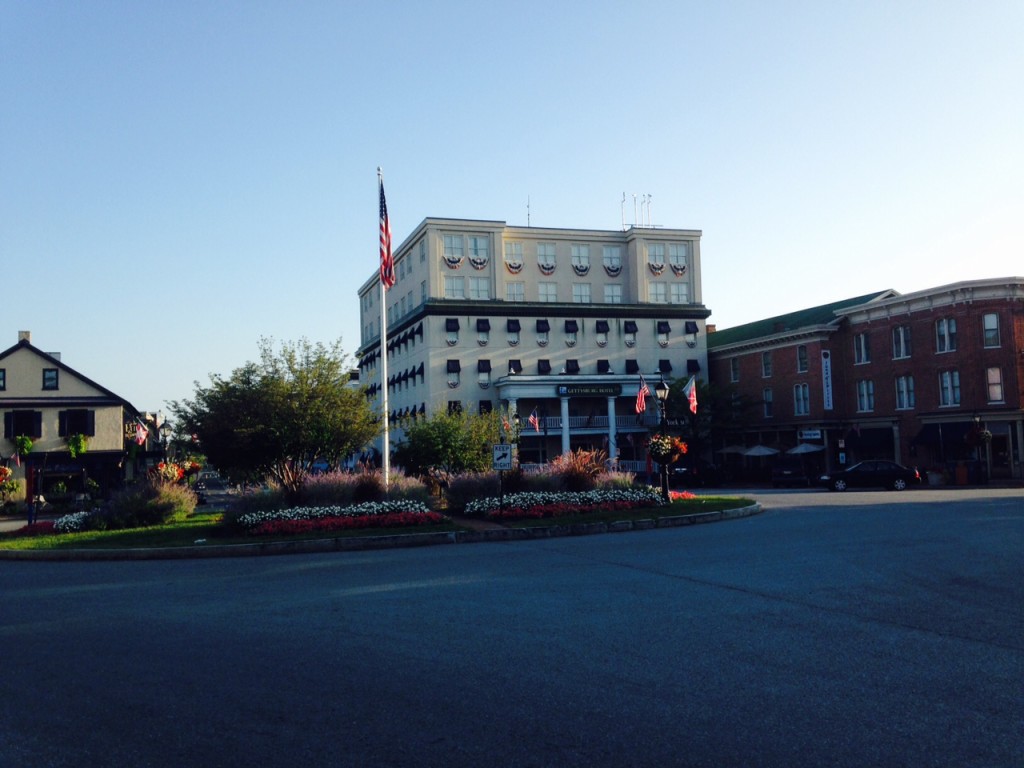
My accommodations, some meals, and admission to historic sites was provided as a guest of Destination Gettysburg. All opinions expressed are my own.
